Physical Address
304 North Cardinal St.
Dorchester Center, MA 02124
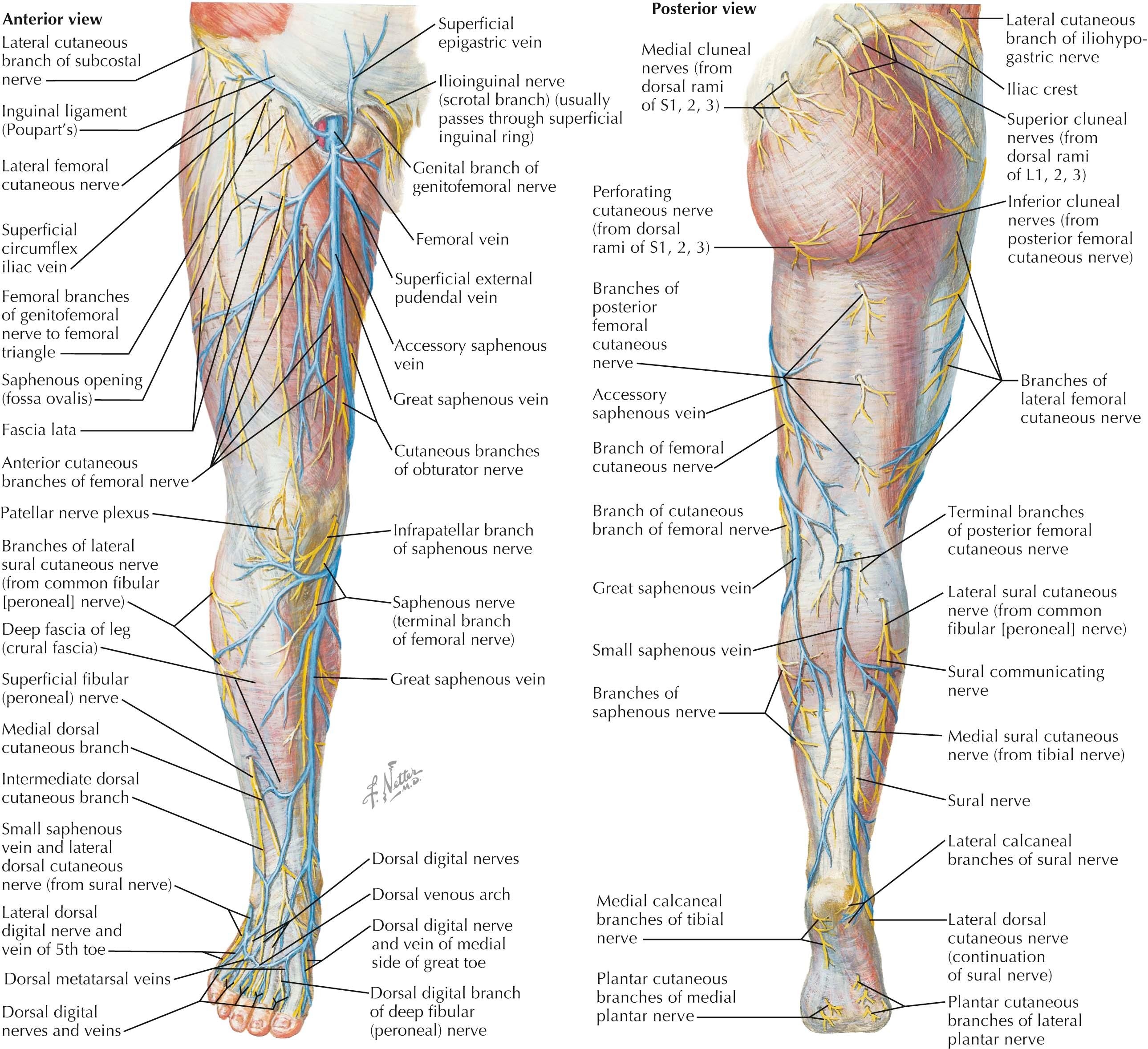
Certain prominent veins, unaccompanied by arteries, are found in the subcutaneous tissue of the lower limb (see Plate 2-1 ). The principal ones are the greater and lesser saphenous veins, which arise in the venous radicles in the feet and toes. Dorsal digital veins lie along the dorsal margins of each digit, uniting at the webs of the toes into short dorsal metatarsal veins that empty into the dorsal venous arch. There are also plantar digital veins, which drain into the dorsal metatarsal veins.
The greater saphenous vein continues the medial end of the dorsal venous arch and is the longest named vein of the body. It turns upward anterior to the medial malleolus at the ankle and, ascending immediately posterior to the medial margin of the tibia, passes the knee against the posterior border of the medial femoral condyle. In the thigh, the vein inclines anteriorly and lateralward; in the femoral triangle, it turns deeply through the saphenous opening to empty into the femoral vein. In the leg, the greater saphenous vein has tributaries from the heel of the foot, the front of the leg, and the calf. It also communicates with radicles of the lesser saphenous vein.
In the thigh, the greater saphenous vein also receives a large accessory saphenous vein, which collects the superficial radicles of the medial and posterior parts. Just before it turns through the saphenous opening, it receives the superficial external pudendal, superficial epigastric, and superficial circumflex iliac veins. On occasion, these veins pierce the cribriform fascia of the saphenous opening independently and empty directly into the femoral vein.
Valves in the greater saphenous vein vary from 10 to 20 in number and are more numerous in the leg than in the thigh. Perforating communications to deep veins pass through the deep fascia at all levels of the limb. Blood passes from superficial to deep through these communications, with valves in the communications determining the direction of drainage. In the leg, the greater saphenous vein is accompanied by a branch of the saphenous nerve; in the thigh, an anterior femoral cutaneous nerve lies next to it.
The lesser saphenous vein, continuing the lateral extension of the dorsal venous arch, receives lateral marginal veins in the foot and passes backward along the lateral border of the foot in company with the sural nerve. It then turns upward to ascend through the middle of the calf. The vein pierces the crural fascia, mostly in the middle third of the leg but frequently in the upper third, and ascends deep to or in a split of the deep fascia. It usually (75% of cases) terminates in the popliteal vein. The lesser saphenous vein has 6 to 12 valves. It communicates with radicles of the greater saphenous vein and also with deep veins of the leg. It frequently gives rise to a radicle, which communicates with the accessory saphenous vein. The lesser saphenous vein is accompanied by the sural nerve in the lower half of the leg; in its terminal course in the popliteal fossa, it has a close anatomic relationship to the tibial nerve.
The deep nerves of the lower limb are discussed separately (see Plates 2-5 to 2-7 ).
Almost all the cutaneous nerves of the lower limb originate from the lumbosacral plexus, which is formed from the ventral rami of the first lumbar to third sacral nerves (L1 to S3) (see Plates 2-5 to 2-7 ). However, the superior and middle cluneal nerves are lateral cutaneous branches of dorsal rami of certain of these nerves. The superior cluneal nerves are branches of the L1 to L3 nerves. They distribute to the skin of the gluteal region as far as the greater trochanter of the femur. The middle cluneal nerves are lateral branches of dorsal rami of S1 to S3 and provide cutaneous innervation to the skin over the back of the sacrum and adjacent gluteal region.
Certain lateral cutaneous branches of primarily abdominal nerves cross the crest of the ilium and distribute in the upper thigh. Thus, the lateral cutaneous branch of the subcostal nerve (T12) distributes to the skin and subcutaneous tissue of the thigh to as low as the greater trochanter of the femur. The lateral cutaneous branch of the iliohypogastric nerve (L1) supplies the skin of the gluteal region posterior to the area of supply of the lateral cutaneous branch of the subcostal nerve. The ilioinguinal nerve of the lumbar plexus has a small femoral distribution through its anterior scrotal (or anterior labial ) branch (L1). Twigs of this nerve reach the skin of the thigh adjacent to the scrotum (or labium majus). The femoral branch of the genitofemoral nerve (L1, 2) arises from the lumbar plexus to supply the skin over the femoral triangle.
Anterior femoral cutaneous nerves (L2, 3) are multiple. They usually arise from the femoral nerve in the femoral triangle on the lateral surface of the femoral artery. Medially distributing representatives, the medial femoral cutaneous nerves, supply the skin and subcutaneous tissues in the distal two thirds of the medial portion of the thigh. Other branches arising in the femoral triangle, the intermediate femoral cutaneous nerves, supply the skin of the distal three fourths of the front of the thigh and extend to the front of the patella, where they assist in forming the patellar plexus.
The lateral femoral cutaneous nerve (L2, 3) is a direct branch of the lumbar plexus. It becomes subcutaneous about 10 cm below the anterior iliac spine and distributes to anterior and lateral aspects of the thigh. Its larger anterior distribution may reach the patellar plexus.
The posterior femoral cutaneous nerve (S1, 2, 3) from the sacral plexus descends in the posterior midline of the thigh deep to the fascia lata, giving off branches that pierce the fascia and distribute both medially and laterally. The nerve finally reaches the levels of the popliteal fossa and the upper calf. The posterior femoral cutaneous nerve, lying subgluteally alongside the sciatic nerve, gives rise to the inferior cluneal nerve. This nerve turns around the lower border of the gluteus maximus muscle and supplies the skin over the lower and lateral parts of the muscle.
A perforating cutaneous nerve (S2, 3) arises from the sacral plexus. It gets its name because it perforates the sacrotuberal ligament and the lower fibers of the gluteus maximus muscle and distributes to the skin over the medial part of the fold of the buttock.
The obturator nerve (L2, 3, 4) from the lumbar plexus is largely muscular in the thigh, but its anterior branch usually ends as a cutaneous branch. This is distributed to the skin of the distal third of the thigh on its medial surface.
The saphenous nerve (L3, 4) is the terminal branch of the femoral nerve, even though it arises in the femoral canal. It traverses the whole length of the adductor canal, at its lower end piercing the vastoadductor membrane to become superficial along with the saphenous branch of the descending genicular artery. It descends in the leg in company with the greater saphenous vein. An infrapatellar branch curves downward below the patella, forming the patellar plexus with terminals of the medial and lateral femoral cutaneous nerves. The saphenous nerve continues distally along the medial surface of the leg, distributing from there and finally reaching the posterior half of the dorsum and the medial side of the foot.
The lateral sural cutaneous nerve (L5; S1, 2) arises in the popliteal space from the common peroneal nerve. It distributes to the skin and subcutaneous connective tissue on the lateral part of the leg in its proximal two thirds. The peroneal communicating branch is a small nerve that usually arises from the lateral sural cutaneous nerve in the popliteal space or over the lateral calf. It runs downward and medially to join the medial sural cutaneous nerve in the middle third of the leg to form the sural nerve.
The medial sural cutaneous nerve (S1, 2) arises from the tibial nerve in the popliteal fossa. It descends as far as the middle of the leg. Here, it is joined by the peroneal communicating nerve to form the sural nerve. The level of junction of these nerves is quite variable, and in about 20% of cases, they fail to unite; the peroneal communicating branch then distributes in the leg, and the medial sural cutaneous nerve supplies the heel and foot areas.
The sural nerve (S1, 2), formed as described earlier, usually becomes superficial at the middle of the length of the leg. It descends in company with the lesser saphenous vein, turning with it under the lateral malleolus onto the side of the foot. As the lateral dorsal cutaneous nerve of the foot, it is cutaneous to the lateral side of the foot, having previously given off lateral calcaneal branches to the ankle and heel. It extends to the little toe, has articular branches to the ankle and tarsal joints, and communicates with the intermediate dorsal cutaneous branch of the superficial peroneal nerve.
The superficial peroneal nerve (L4, 5; S1), a branch of the common peroneal nerve, descends to the distal third of the leg, where it almost immediately divides into two terminal branches. The medial dorsal cutaneous nerve supplies cutaneous twigs in the distal third of the leg and then, crossing the extensor retinaculum, divides over the dorsum of the foot into two or three branches for the supply of the dorsum and sides of the medial  toes. The deep peroneal nerve (L4, 5) has cutaneous terminals to the web and adjacent sides of the great and second toes; and in this interval, the terminals of the medial dorsal cutaneous nerve merely communicate with the branches of the deep peroneal nerve.
toes. The deep peroneal nerve (L4, 5) has cutaneous terminals to the web and adjacent sides of the great and second toes; and in this interval, the terminals of the medial dorsal cutaneous nerve merely communicate with the branches of the deep peroneal nerve.
The intermediate dorsal cutaneous nerve passes more laterally over the dorsum of the foot and divides into cutaneous branches to the lateral side of the ankle and the foot. It terminates in dorsal digital branches for the adjacent sides of the third and fourth and fourth and fifth toes. The more lateral branch communicates with the lateral dorsal cutaneous nerve. As in the fingers, the dorsal digital branches to the toes are smaller than the corresponding plantar digital nerves and distribute distalward only over the middle phalanges. The terminal segment of the toes is supplied by dorsal terminals of the plantar nerves.
The tibial nerve supplies the musculature of the back of the leg and continues into the foot behind the medial malleolus. Its medial calcaneal branches (S1, 2) distribute to the heel and the posterior part of the sole of the foot. Derived from the tibial nerve deep to the abductor hallucis muscle are the medial and lateral plantar nerves. The medial plantar nerve (L4, 5) provides a proper digital nerve to the medial side of the great toe and three common digital branches. Each of the latter splits into two proper digital nerves, which supply the skin of the adjacent sides of digits I and II, II and III, and III and IV, respectively. The lateral plantar nerve (S1, 2) provides a common digital nerve, which also divides into proper digital nerves; two of them reach the adjacent sides of the fourth and fifth toes, and one reaches the lateral side of the little toe. The plantar digital nerves reach the whole plantar surface of the digits and also furnish small dorsal twigs for the nail bed and tip of each toe.
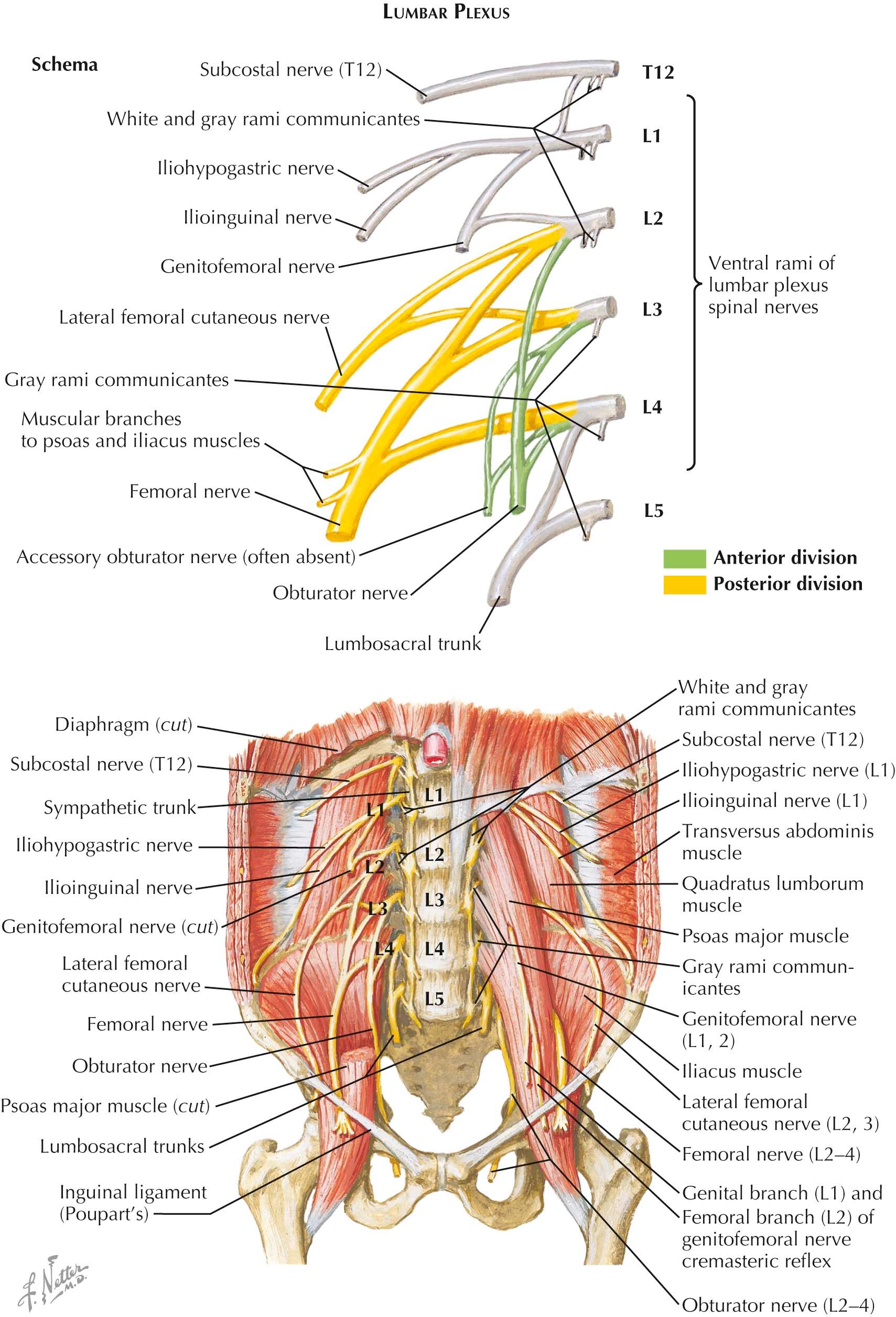
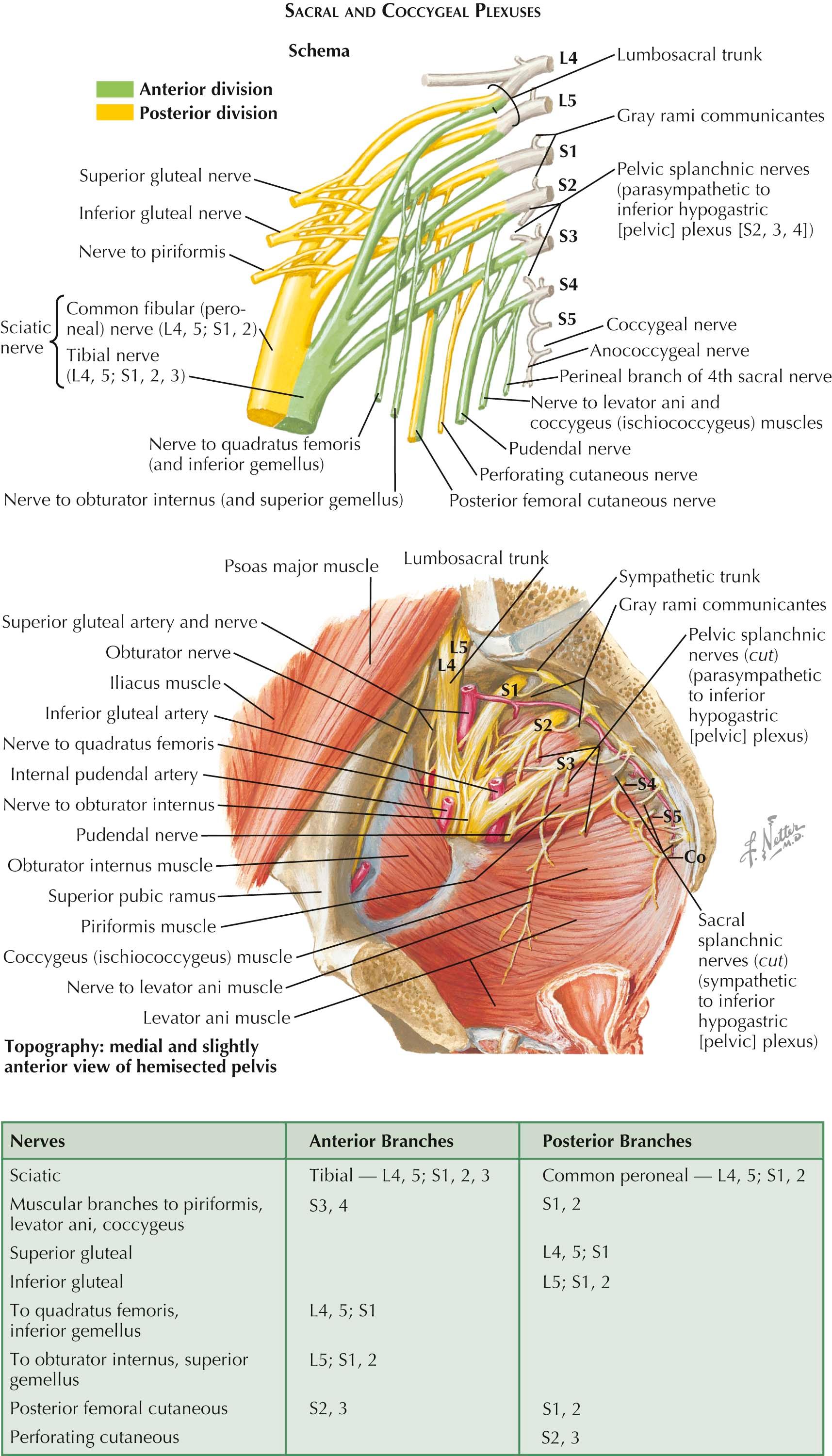
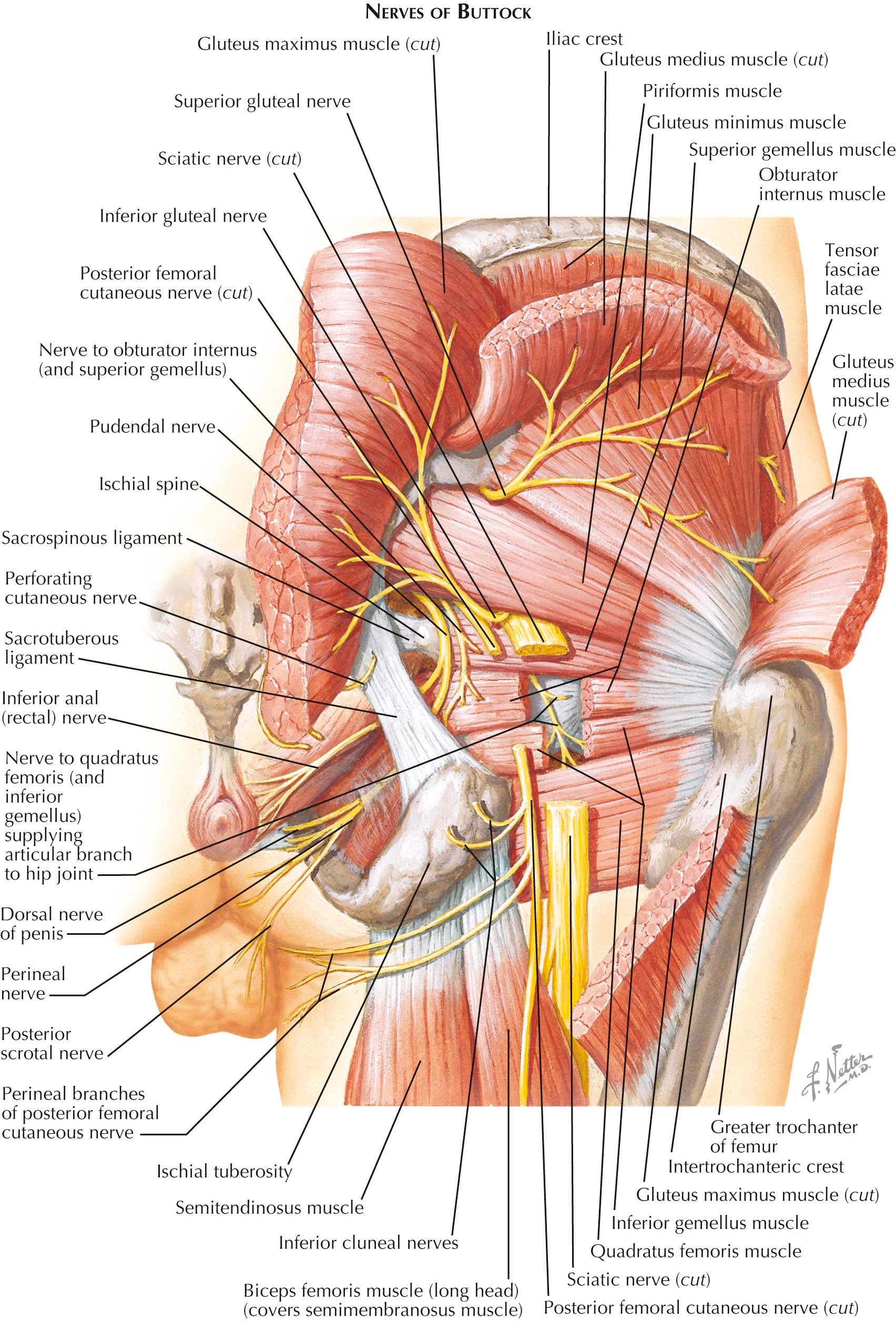
In describing the lower limb, the lumbosacral plexus may be said to be formed from the ventral rami of the first lumbar to third sacral nerves (L1 to S3), with a common small contribution from the 12th thoracic nerve (T12) (see Plates 2-2 to 2-4 ). The lumbar portion of the plexus arises from the four upper lumbar nerves and gives rise to the iliohypogastric, ilioinguinal, genitofemoral, lateral femoral cutaneous, obturator, accessory obturator, and femoral nerves.
As with the brachial plexus, the spinal nerves contributing to the lumbar plexus divide into anterior and posterior branches, but the plexus lacks some of the complexity of the brachial plexus, because the definitive nerves usually arise from combinations of looping contributions from adjacent spinal nerves. The lumbar plexus is formed deep to the psoas major muscle and lies anterior to the transverse processes of the lumbar vertebrae (see Plate 2-2 ). Only the first two lumbar nerves contribute preganglionic sympathetic fibers to the sympathetic chain through white rami communicantes; all lumbar nerves receive postganglionic fibers through gray rami communicantes.
The iliohypogastric nerve arises from L1 together with a frequent contribution from T12. It emerges from the psoas major muscle at its lateral border and crosses the quadratus lumborum muscle to penetrate the transverse abdominal muscle near the iliac crest. This nerve, primarily motor to abdominal musculature, ends in an anterior cutaneous branch to the skin of the suprapubic region and a lateral cutaneous branch that crosses the iliac crest to distribute in the hip region. A lateral cutaneous branch of the subcostal nerve (T12) also supplies the upper thigh.
The ilioinguinal nerve from L1 has a similar course to the iliohypogastric nerve in the abdominal wall but enters the lateral end of the inguinal canal and accompanies the spermatic cord through that canal. Emerging at the superficial inguinal ring, it ends as the anterior scrotal (or anterior labial) nerve as a cutaneous nerve to the scrotum and adjacent area of the thigh. In about 35% of cases, the ilioinguinal nerve combines with the genitofemoral nerve in the abdomen, running with the latter on the surface of the psoas major muscle, but distributes finally in its typical cutaneous distribution.
The genitofemoral nerve arises by a union of branches from the anterior portions of L1 and L2. In the abdomen, it descends on the ventral surface of the psoas major muscle and then divides into genital and femoral branches. The genital branch innervates the cremaster muscle and gives twigs to the scrotum and adjacent thigh; the more medial femoral branch descends under the inguinal ligament on the surface of the external iliac artery to supply the skin of the femoral triangle.
The lateral femoral cutaneous nerve arises from the posterior branches of L2 and L3 (see Plates 2-2 and 2-5 ).
The obturator nerve is the largest nerve formed from the anterior divisions of the lumbar plexus, specifically from those of L2 to L4. The accessory obturator nerve is small and is present in only 9% of cases. (The obturator nerve is fully described in Plate 2-6 .)
The femoral nerve, the largest branch of the lumbar plexus, is formed from the posterior branches of L2 to L4. Passing under the inguinal ligament, it shortly breaks up in the femoral triangle into its numerous branches. (This nerve is fully described in Plate 2-5 .)
Muscular branches of the lumbar plexus distribute to the quadratus lumborum muscle (T12; L1, 2, 3 [4]), the psoas major muscle ([L1], 2, 3, 4), the psoas minor muscle (L1, 2), and the iliacus muscle (L2, 3, 4).
The sacral portion of the lumbosacral plexus, commonly designated the sacral plexus, is formed from the ventral rami of a part of the fourth lumbar nerve (L4) and the fifth lumbar and first, second, and third sacral nerves (L5; S1, 2, 3) (see Plate 2-3 ). The descending portion of L4 joins L5 over the ala of the sacrum to form the lumbosacral trunk, which then descends across the sacroiliac articulation to join the ventral ramus of S1. The lumbosacral trunk contains anterior and posterior branches of the ventral rami of L4 and L5. The ventral rami of S1, 2, 3 pass lateralward from the pelvic sacral foramina and divide into anterior and posterior branches in front of the piriformis muscle. The largest nerves of the sacral plexus are L5 and S1, and the superior gluteal artery usually leaves the pelvis by passing between them.
Converging toward the lower portion of the greater sciatic foramen, the plexus forms a broad triangular band, the apex of which passes through the foramen into the gluteal region. The pelvic splanchnic nerves, arising from the ventral rami of S2 to S4, represent the important sacral part of the craniosacral (parasympathetic) portion of the autonomic nervous system. They join the inferior hypogastric plexus and have a largely pelvic and perineal distribution. All the nerves of the plexus receive gray rami communicantes from the sympathetic chain ganglia or trunk.
The principal nerve of the sacral plexus is the sciatic nerve (see Plate 2-7 ). It is composed of an anteriorly derived nerve, the tibial segment, and a nerve formed from posterior branches, the common peroneal nerve. These two nerves are usually combined in a single sheath, but in 10% of cases the two parts are separated in the greater sciatic foramen by all or part of the piriformis muscle. They are occasionally separate throughout the thigh. The nerves of the plexus and their sources are listed in tabular format on Plate 2-3 .
The sciatic nerve usually emerges from the pelvis at the lower border of the piriformis muscle and enters the thigh in the hollow between the ischial tuberosity and the greater trochanter of the femur (see Plate 2-7 ).
The nerve to the piriformis muscle may be represented by separate contributions from S1 and S2. Twigs arise from the dorsal aspect of these nerves and immediately enter the pelvic surface of the muscle. Muscular nerves to the levator ani and coccygeus muscles arise from the loop between the rami of S3 and S4 and descend to enter the pelvic surface of these muscles.
The superior gluteal nerve, from the posterior branches of L4, 5 and S1, passes from the pelvis above the piriformis muscle. Deep to the gluteus maximus and gluteus medius muscles, the nerve accompanies the superior gluteal vessels anteriorly over the surface of the gluteus minimus muscle. It supplies the gluteus medius and minimus muscles and, continuing beyond them, the tensor fasciae latae muscle.
The inferior gluteal nerve, formed from the posterior branches of L5 and S1, 2, passes from the pelvis below the piriformis muscle. It enters the deep surface of the gluteus maximus muscle, to which it is the sole supply.
The nerve to the quadratus femoris and inferior gemellus muscles is formed from the anterior branches of L4, 5 and S1. In the gluteal region, it is deep to the sciatic nerve and descends over the back of the ischium anterior to the gemellus muscles and the tendon of the internal obturator muscle. It provides articular branches to the hip joint and a branch to the inferior gemellus muscle and ends in the anterior surface of the quadratus femoris muscle.
The nerve to the obturator internus and superior gemellus muscles arises from anterior branches of L5 and S1, 2. In the gluteal region, it is inferomedial to the sciatic nerve and on the lateral side of the internal pudendal vessels. It crosses the superior gemellus muscle and supplies a small nerve to it. The remaining nerve to the obturator internus muscle crosses the ischial spine and enters the ischiorectal fossa through the lesser sciatic foramen. It ends in the perineal surface of the muscle.
The posterior femoral cutaneous nerve is a mixed nerve, formed by posterior branches from S1 and S2 and anterior branches from S2 and S3; its cutaneous distributions are described on page 57 . In the gluteal region, it lies alongside the sciatic nerve and descends in the midline of the thigh. It also provides perineal branches that are cutaneous in the perineum and the back of the scrotum.
The perforating cutaneous nerve arises from posterior branches of S2 and S3 and is associated at its origin with the lower roots of the posterior femoral cutaneous nerve. Its cutaneous distribution is described on page 57 .
As in the upper limb, the serial order of distribution of lower limb nerves as seen in the lumbosacral plexus is retained in the cutaneous zones of appropriate nerves in the limb. The lumbar nerves have cutaneous terminals that distribute from above down and lateromedially. Sacral segments are restricted to the posterior aspect of the limb and the lateral side of the foot. The spiraling of nerve distribution is a consequence of the medial rotation of the lower limbs of almost 90 degrees that takes place in development, so that the future knees point ventrolaterally (see Plates 2-5 to 2-7 ). There is always an overlap of adjacent segments; therefore, the lines of separation are indistinct.
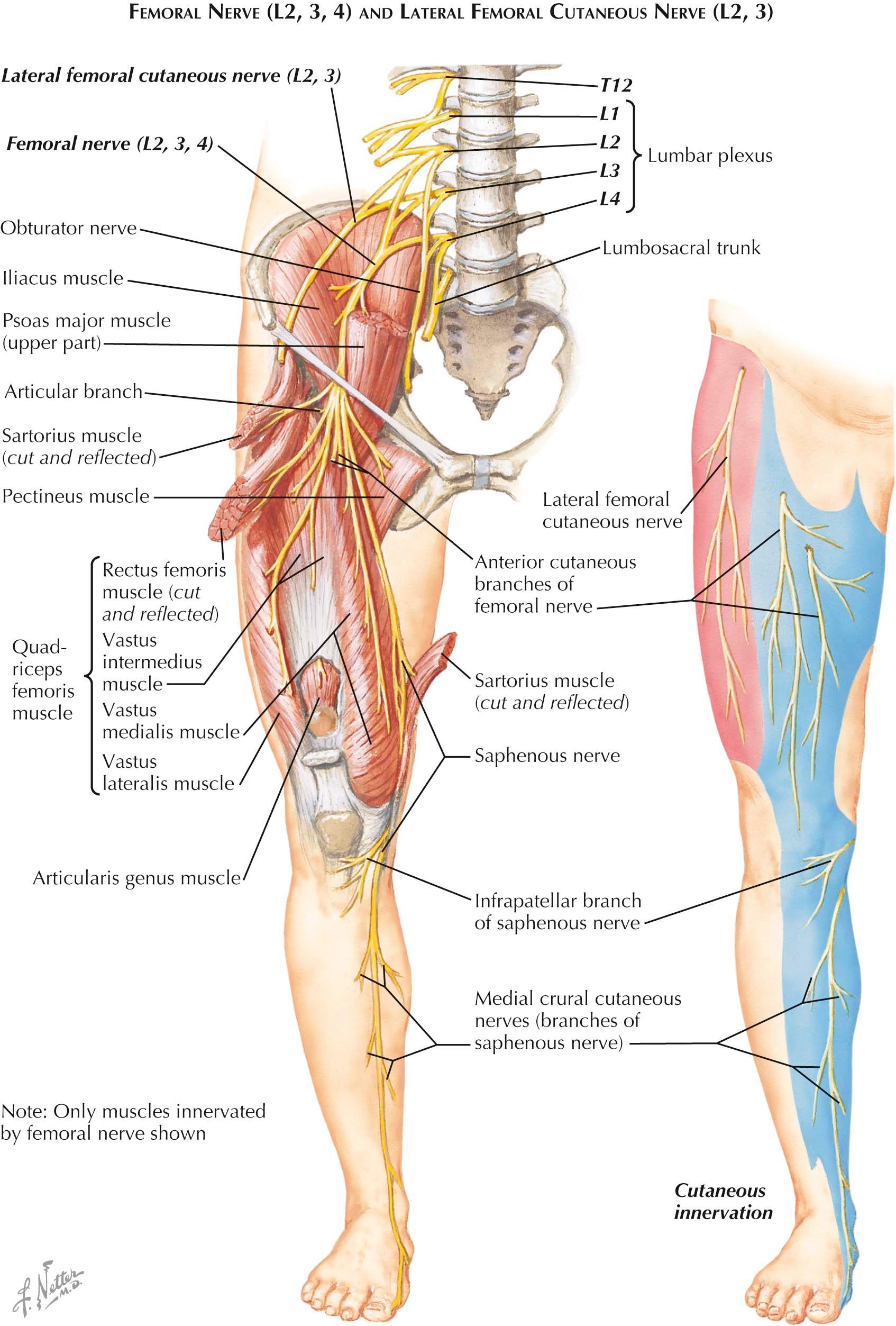
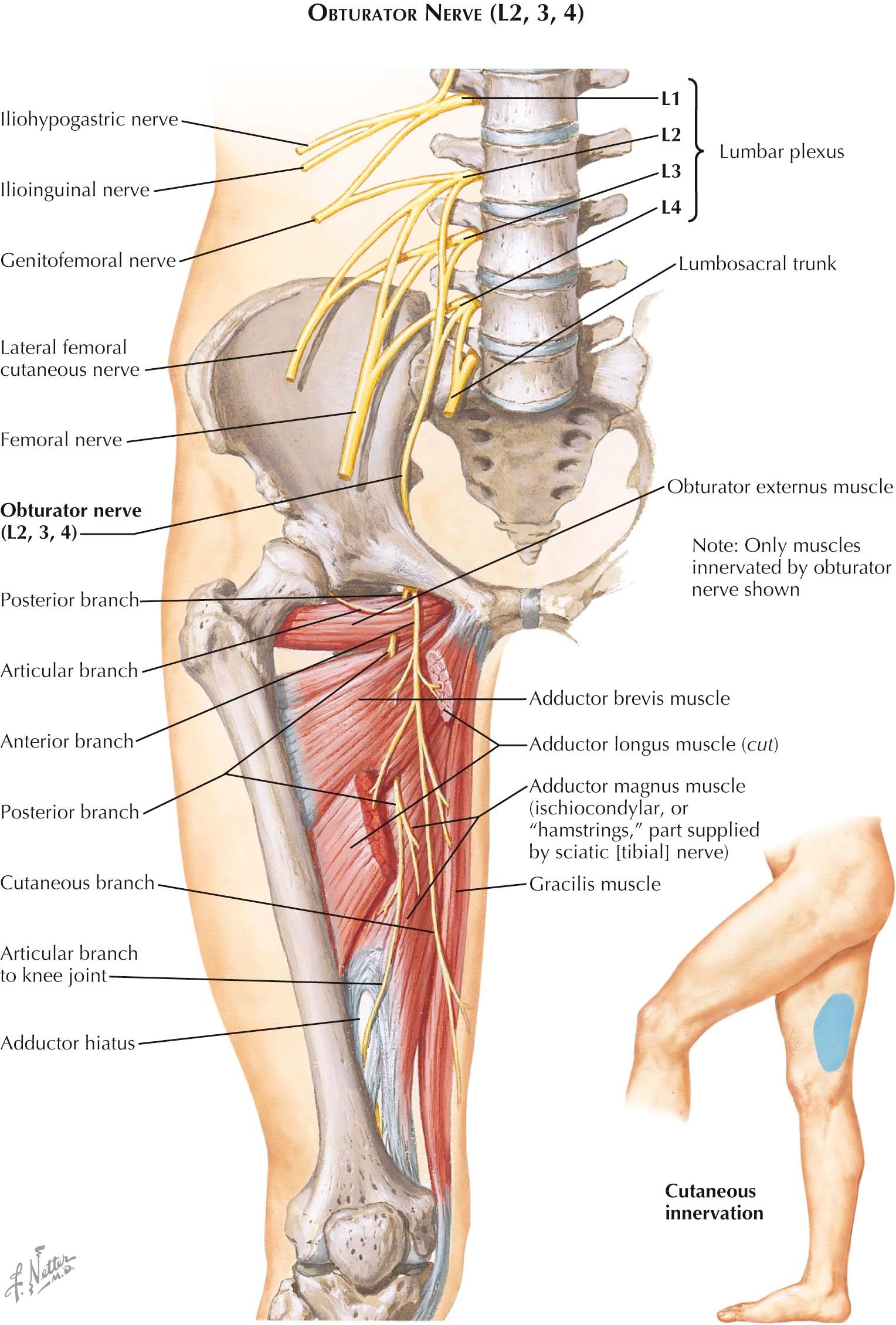
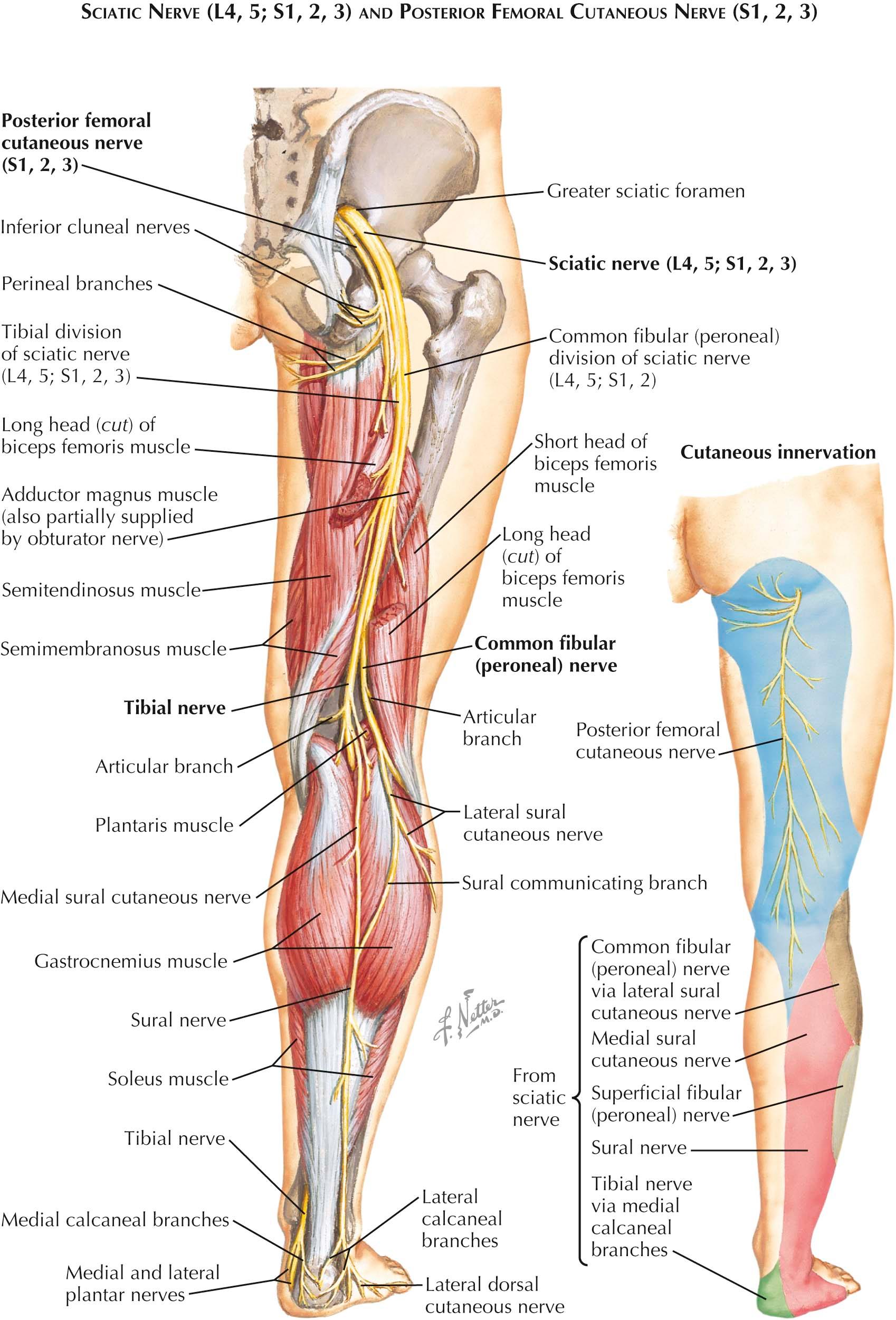
The femoral nerve (L2, 3, 4) is the largest branch of the lumbar plexus (see Plate 2-5 ). It originates from the posterior divisions of the ventral rami of the second, third, and fourth lumbar nerves, passes inferolaterally through the psoas major muscle, and then runs in a groove between this muscle and the iliacus, which it supplies. It enters the thigh behind the inguinal ligament to lie lateral to the femoral vascular sheath in the femoral triangle. Twigs are given off to the hip and knee joints and adjacent vessels, and cutaneous branches are given off to anteromedial aspects of the lower limb.
Muscular branches supply the pectineus, sartorius, and quadriceps femoris muscles. The nerve to the pectineus muscle arises at the level of the inguinal ligament, whereas the branches to the sartorius muscle enter the upper two thirds of the muscle, several arising in common with the anterior femoral cutaneous nerves. The branches to the quadriceps femoris muscle are arranged as illustrated, and those to the rectus femoris and vastus lateralis muscles enter the deep surfaces of the muscles. The branch to the vastus intermedius muscle enters its superficial surface and pierces the muscle to supply the underlying articularis genus muscle. The branch to the vastus medialis muscle runs in the adductor canal for a variable distance, on the lateral side of the femoral vessels and saphenous nerve, giving off successive branches to this muscle, some of which end in the vastus intermedius and articularis genus muscles.
The anterior femoral cutaneous nerves arise in the femoral triangle. All these branches pierce the fascia lata 8 to 10 cm distal to the inguinal ligament and descend to knee level, supplying the skin and fascia over the front and medial sides of the thigh.
The saphenous nerve is the largest and longest of the femoral branches. It arises at the femoral triangle and descends through it on the lateral side of the femoral vessels to enter the adductor canal. Here, it crosses the vessels obliquely to lie on their medial side in front of the lower end of the adductor magnus muscle. In the canal, the saphenous nerve communicates with branches of the anterior femoral cutaneous and obturator nerves to form the subsartorial plexus. At the lower end of the canal, it leaves the femoral vessels and gives off its infrapatellar branch, which curves around the posterior border of the sartorius muscle, pierces the fascia lata, and runs onward to supply the skin over the medial side and front of the knee and the patellar ligament. This branch assists offshoots from the anterior and lateral femoral cutaneous nerves in forming the patellar plexus.
The saphenous nerve continues its descent on the medial side of the knee, pierces the fascia lata between the tendons of the sartorius and gracilis muscles, courses downward on the medial side of the leg close to the greater saphenous vein, and gives off its medial crural cutaneous branches. In the lower leg, it subdivides terminally—the smaller branch follows the medial tibial border to the level of the ankle and the larger passes anterior to the medial malleolus to distribute to the skin and fascia on the medial side and dorsum of the foot.
Articular branches arising from the nerve to the rectus femoris muscle accompany the corresponding branches of the lateral femoral circumflex artery to the hip joint. Twigs from the branches to the vastus muscles and from the saphenous nerve supply the knee joint.
The lateral femoral cutaneous nerve (L2, 3) emerges from the lateral border of the psoas major muscle, passes obliquely over the iliacus muscle behind the parietal peritoneum and iliac fascia (which it supplies) toward the anterior superior iliac spine, and enters the thigh by passing under or through the lateral end of the inguinal ligament (see Plate 2-5 ). The nerve then passes over or through the proximal part of the sartorius muscle and descends deep to the fascia lata. It gives off a number of small branches to the overlying skin before piercing the fascia about 10 cm below the inguinal ligament. The terminal branches of the lateral femoral cutaneous nerve supply the skin and fascia on the anterolateral surfaces of the thigh between the levels of the greater trochanter of the femur and the knee.
The obturator nerve (L2, 3, 4) supplies the obturator externus and adductor muscles of the thigh, gives filaments to the hip and knee joints, and has a variable cutaneous distribution to the medial sides of the thigh and leg (see Plate 2-6 ).
The obturator nerve arises from the anterior divisions of the ventral rami of the second, third, and fourth lumbar nerves. The contribution from L2 is commonly the smallest and is sometimes absent. These roots unite within the posterior part of the psoas major muscle, forming a nerve that descends through the muscle to emerge from its medial border opposite the upper end of the sacroiliac joint. The obturator nerve runs outward and downward over the sacral ala and pelvic brim into the lesser pelvis, lying lateral to the ureter and internal iliac vessels. It then bends anteroinferiorly to follow the curvature of the lateral pelvic wall (anterior to the obturator vessels and lying on the obturator internus muscle) to reach the obturator groove at the upper part of the obturator foramen. The nerve passes through this groove and foramen to enter the thigh and divides into anterior and posterior branches shortly thereafter.
The anterior branch runs in front of the obturator externus and adductor brevis muscles and behind the pectineus and adductor longus muscles. Near its origin, it gives off an articular twig that enters the hip joint through the acetabular notch. Rarely, it supplies a branch to the pectineus muscle and sends muscular branches to the adductor longus, adductor gracilis, and adductor brevis muscles. The anterior branch finally divides into cutaneous, vascular, and communicating branches.
The cutaneous branch is inconstant. When present, it unites with branches of the saphenous and anterior femoral cutaneous nerves in the adductor canal to form the subsartorial plexus and assists in the innervation of the skin and fascia over the distal two thirds of the medial side of the thigh. Infrequently, this branch is larger and passes between the adductor longus and gracilis muscles to descend behind the sartorius to the medial side of the knee and the adjacent part of the leg, where it assists the saphenous nerve in the cutaneous supply of those areas.
The vascular branches end in the femoral artery. Other fine communicating branches may link the obturator nerve with the anterior and posterior femoral cutaneous nerves and the inconstant accessory obturator nerve.
The posterior branch pierces the anterior part of the obturator externus muscle and supplies it. Thereafter, the nerve runs downward between the adductor brevis and adductor magnus muscles and splits into branches that are distributed to the upper (adductor) part of the adductor magnus and sometimes to the adductor brevis (especially if the latter does not receive a supply from the anterior branch of the obturator nerve). A slender branch emerges from the lower part of the adductor magnus, passes through the hiatus of the adductor canal together with the femoral artery, and then continues to the knee joint. The posterior branch contributes filaments to the femoral and popliteal vessels and ends by perforating the oblique popliteal ligament to supply the articular capsule, cruciate ligaments, and synovial membrane of the knee joint. The fibers to the capsule and ligaments are mostly of somatic origin, whereas those to the synovial membrane are mainly sympathetic.
The accessory obturator nerve (L3, 4) is inconstant, small, and derived from the anterior divisions of the ventral rami of L3 and L4. It descends on the medial border of the psoas muscle and then crosses the superior pubic ramus to lie behind the pectineus muscle. It ends by helping to supply the pectineus but may also supply one twig to the hip joint and another twig that joins the anterior branch of the obturator nerve.
The roots of the sciatic nerve (L4, 5; S1, 2, 3) arise from the ventral rami of the fourth lumbar to third sacral nerves and unite to form a single trunk that is ovoid in cross section and 16 to 20 mm wide in adults (see Plate 2-7 ). In the lesser pelvis, the nerve lies anterior to the piriformis muscle, below which it enters the buttock through the greater sciatic foramen (in about 2% of individuals, the nerve pierces the piriformis). Next, the nerve inclines laterally beneath the gluteus maximus muscle, where it rests on the posterior surface of the ischium and the nerve to the quadratus femoris muscle. On its medial side, it is accompanied by the posterior femoral cutaneous nerve and by the inferior gluteal artery and its special branch to the nerve.
On reaching a point about midway between the ischial tuberosity and the greater trochanter of the femur, the nerve turns downward over the gemellus muscles, the obturator internus tendon, and the quadratus femoris muscle (which separate it from the hip joint) and leaves the buttock to enter the thigh beneath the lower border of the gluteus maximus muscle.
The sciatic nerve then descends near the middle of the back of the thigh, lying on the adductor magnus muscle and being crossed obliquely by the long head of the biceps femoris muscle. Just above the apex of the popliteal fossa, it is overlapped by the contiguous margins of the biceps femoris and semimembranosus muscles. In about 90% of cases the sciatic nerve divides into its terminal tibial and common peroneal branches near the apex of the popliteal fossa, whereas in 10% of cases the division occurs at higher levels. Rarely, the tibial and common peroneal nerves arise independently from the sacral plexus but pursue closely related courses until they reach the apex of the popliteal fossa.
In the buttock, the sciatic nerve supplies an articular branch to the hip, which perforates the posterior part of the joint capsule (see Plate 2-4 ). It may also supply vascular filaments to the inferior gluteal artery. (The entrance of the sciatic nerve and its variable relationship to the piriformis muscle are described on page 60 .)
At levels below the quadratus femoris muscle, two branches of the tibial division of the sciatic nerve spring from its medial side to supply the so-called hamstring muscles of the thigh. The upper branch passes to the long head of the biceps femoris muscle and the upper portion of the semitendinosus; the lower branch innervates the lower portion of the semitendinosus and the semimembranosus muscles and the ischiocondylar portion of the adductor magnus muscle. The nerve to the short head of the biceps femoris muscle arises from the lateral side of the sciatic nerve (common peroneal division of the sciatic nerve) in the middle third of the thigh and enters the superficial surface of the muscle. From this nerve, an articular branch continues to the knee, providing proximal and distal branches that accompany the lateral superior genicular and lateral inferior genicular arteries to the knee joint.
The tibial and common peroneal nerves arise by a division of the sciatic nerve, usually at the upper limit of the popliteal fossa. The tibial nerve continues the vertical course of the sciatic nerve at the back of the knee and into the leg (see Plate 2-7 ). The common peroneal nerve follows the tendon of the biceps femoris muscle along the upper lateral margin of the popliteal space and into the leg, curving forward around the neck of the fibula (see Plate 2-7 ).
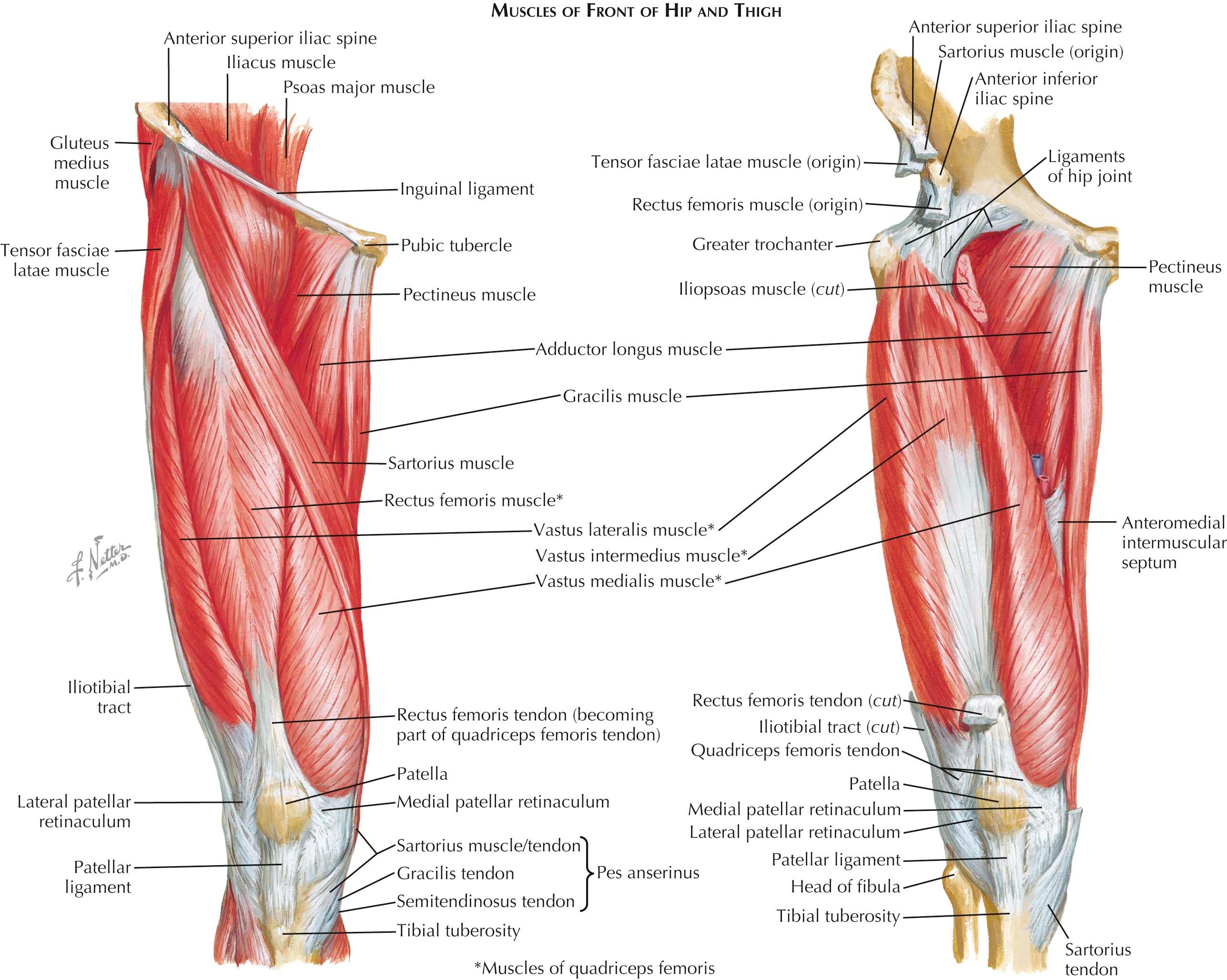
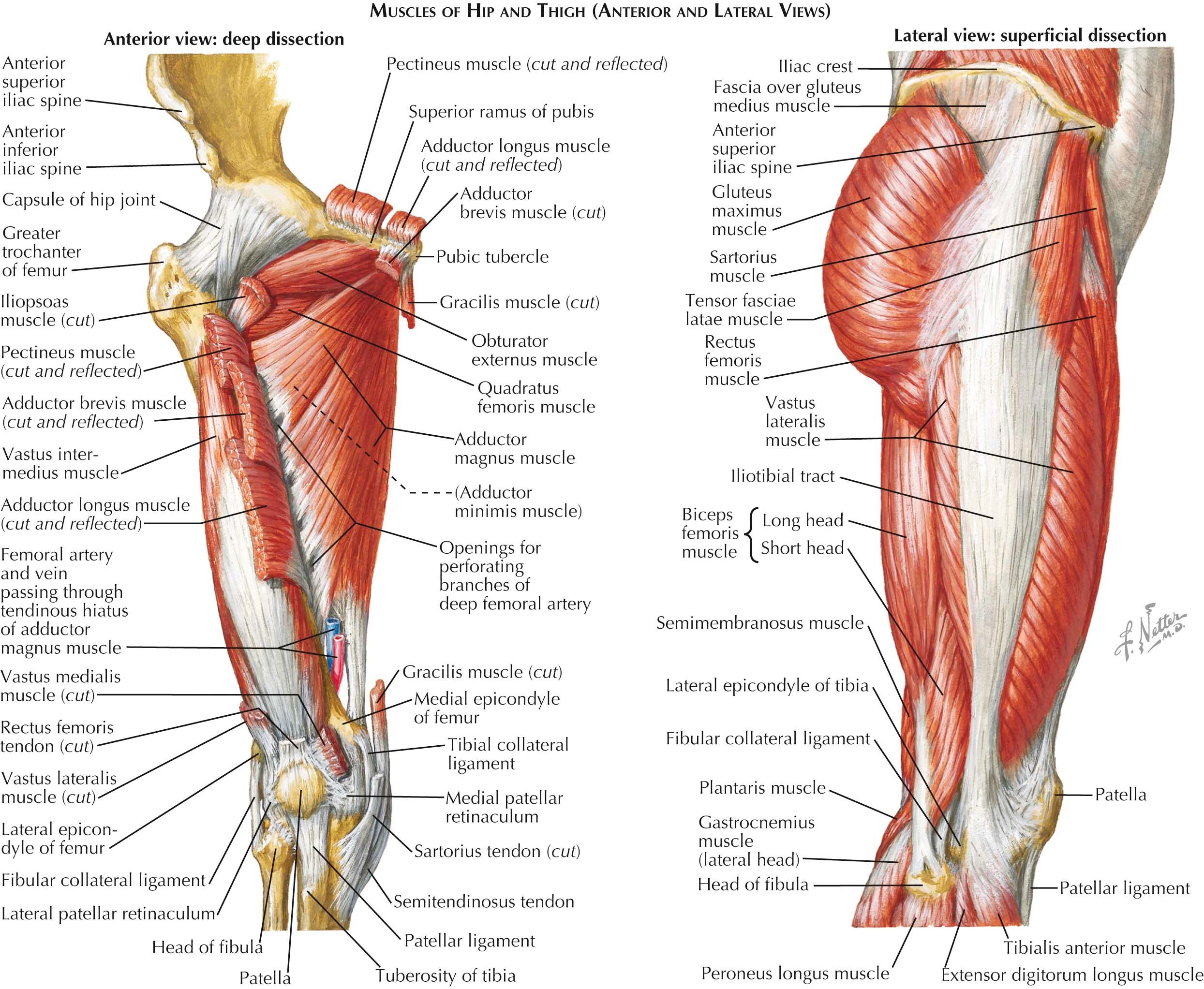
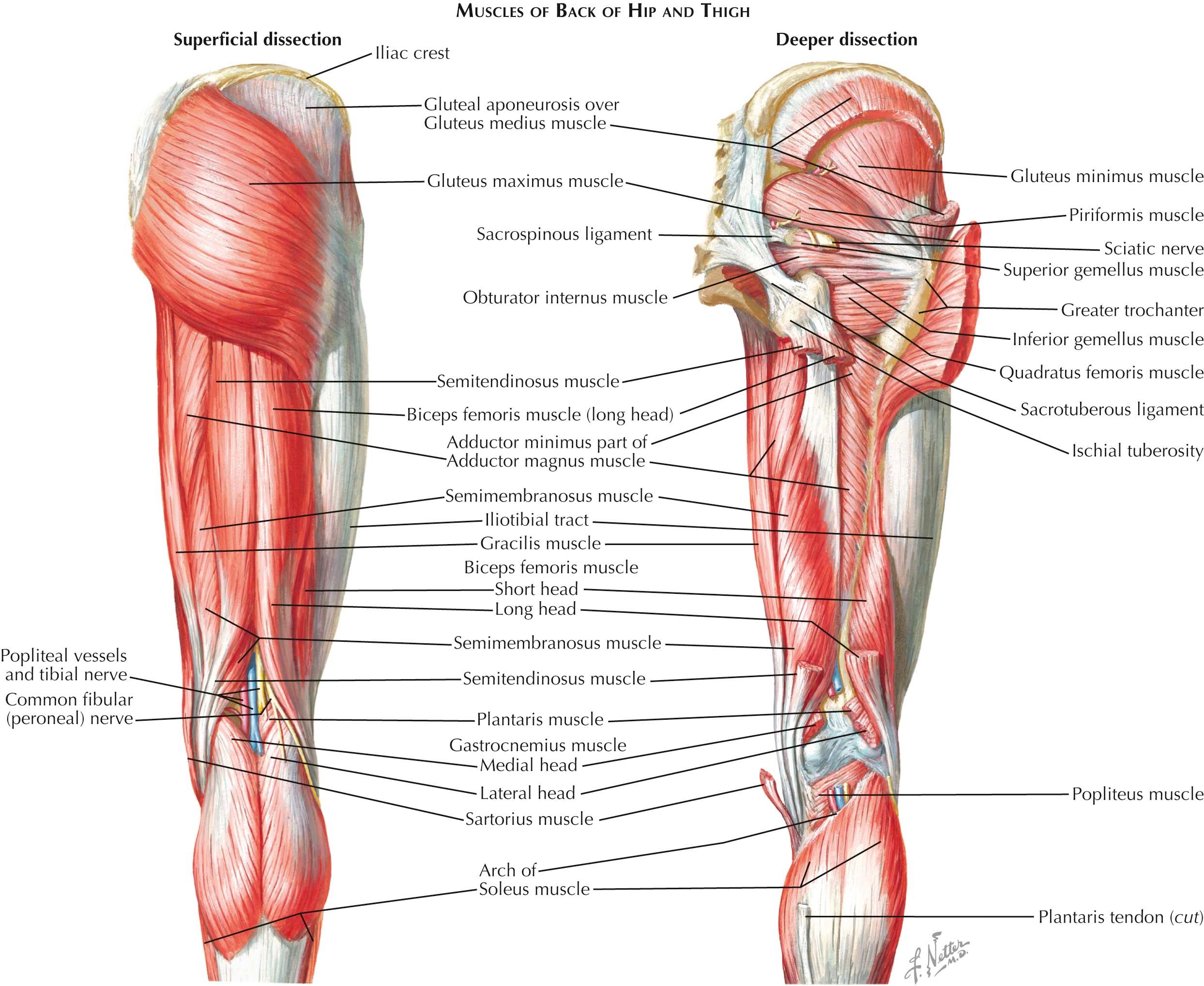
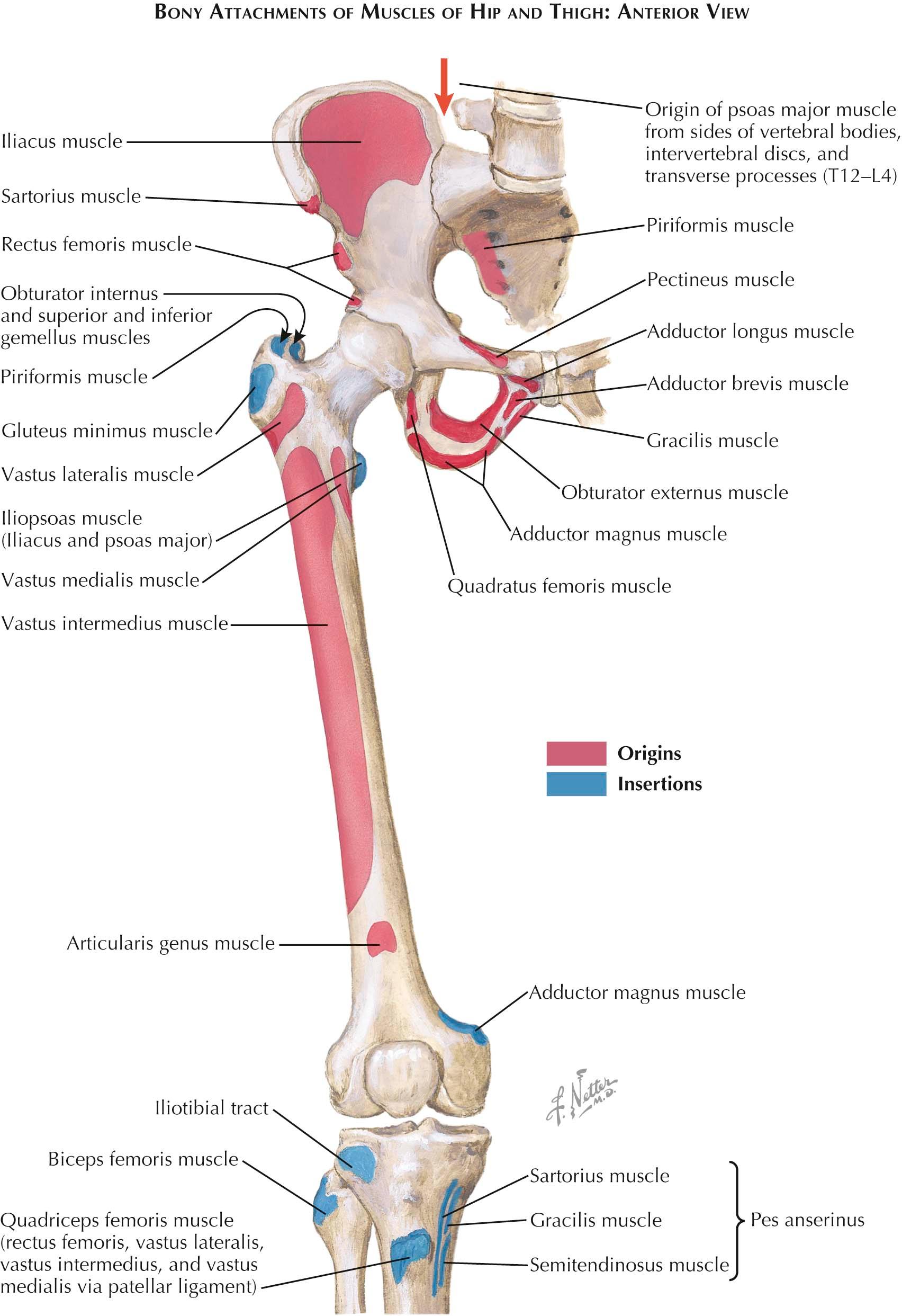
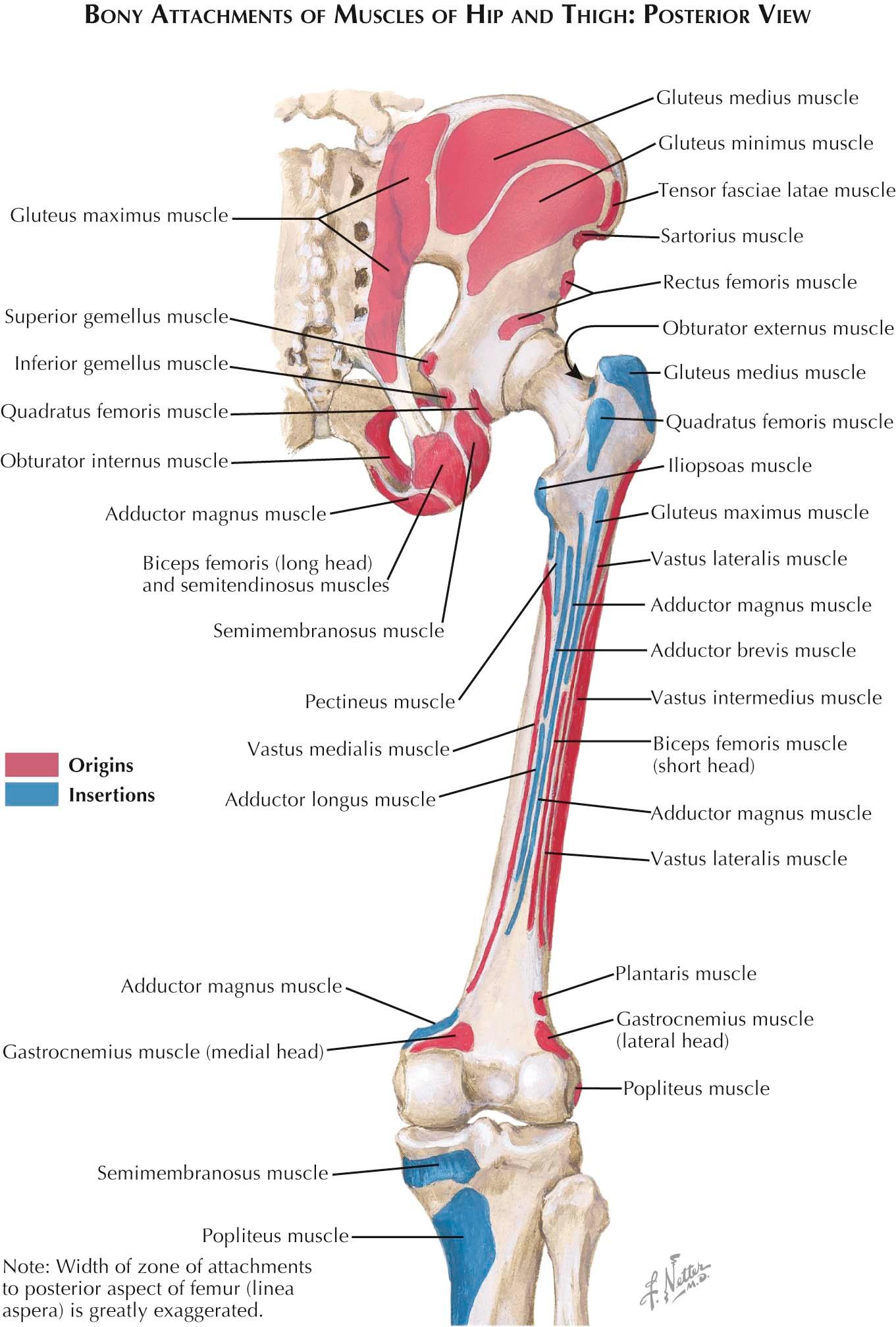
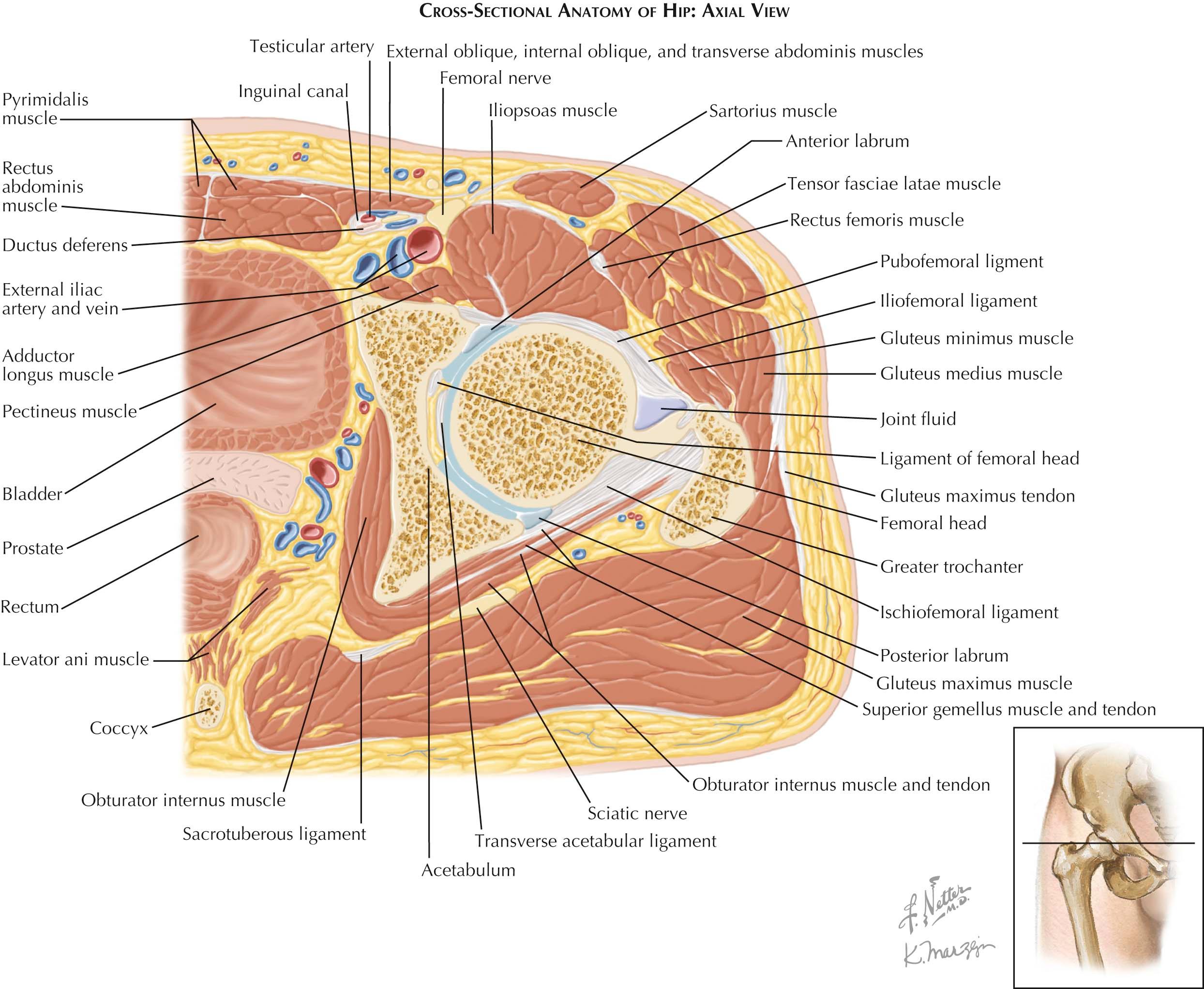
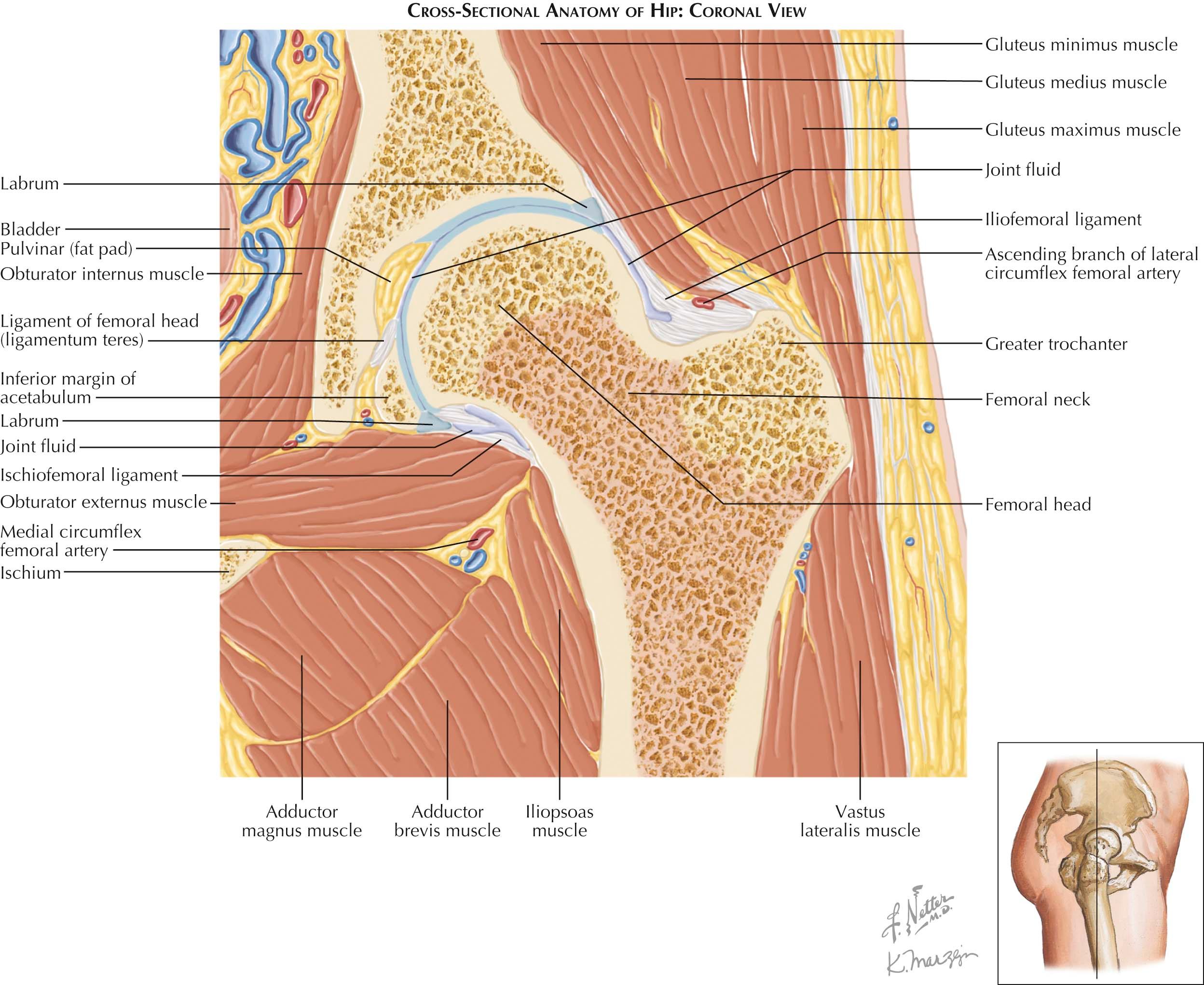
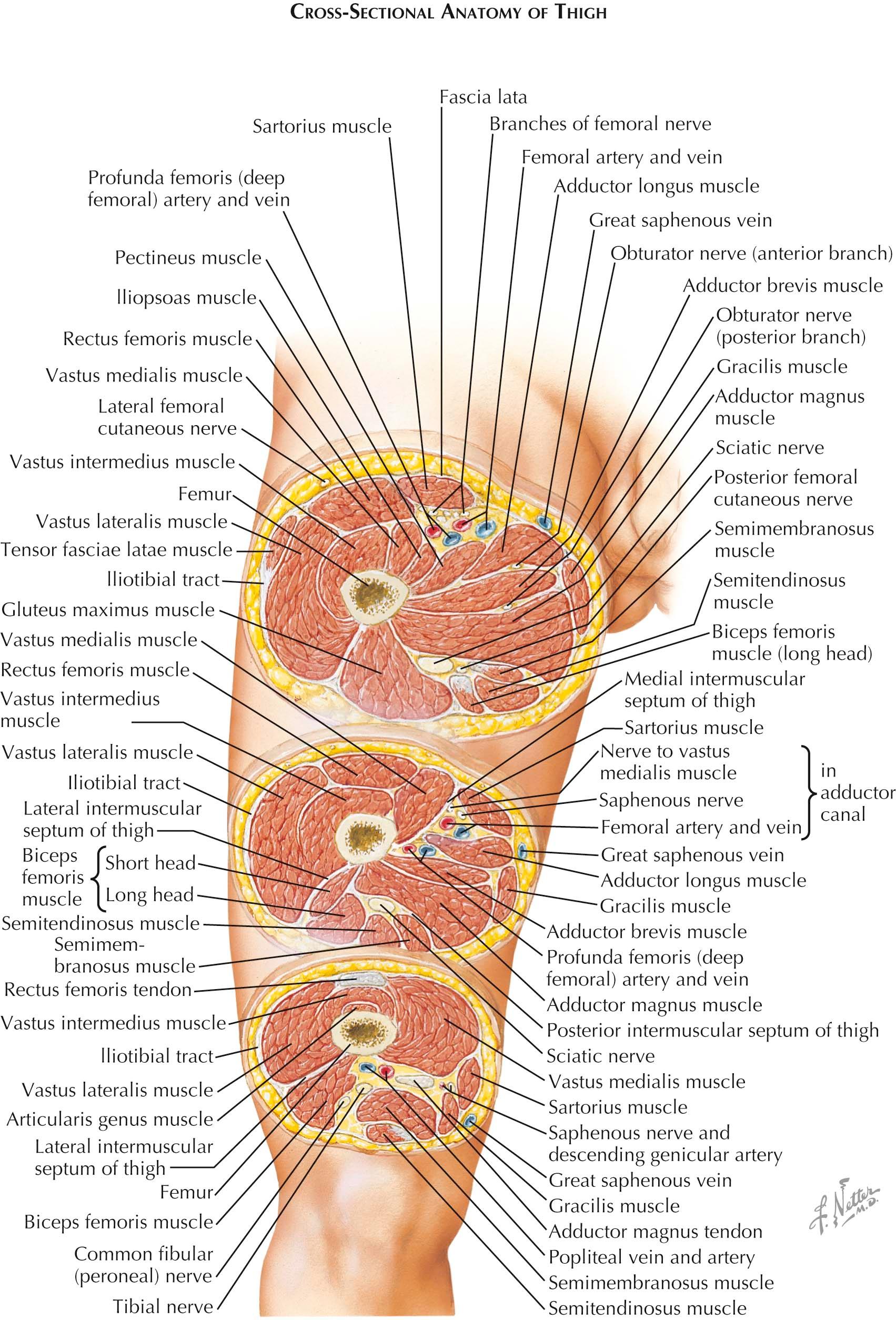
The region of the hip and thigh extends from the iliac crest to the knee. The upper portion is the hip, which is limited generally by the level of the greater trochanter of the femur. The subcutaneous connective tissue contains a considerable amount of fat, especially in the gluteal region. The subcutaneous tissue here is continuous with the similar layer of the lower abdomen, and the membranous layer of the latter region continues beyond the inguinal ligament to become attached to the fascia lata a short distance beyond the ligament. The layer attaches medially to the pubic tubercle and laterally to the iliac crest. It also attaches to the margins of the saphenous opening and fills the opening itself with the cribriform fascia, a subcutaneous connective tissue perforated for the passage of the greater saphenous vein and other blood and lymphatic vessels.
The fascia lata is the uppermost division of a complete stocking-like investment of the soft parts of the limb (see Plate 2-9 ). Below the knee, this investment is represented by the crural fascia and the plantar and dorsal fasciae of the foot. The fascia lata is strong, thicker where it has tendinous contributions and thinner in the gluteal region. It has a complete bony attachment to the pelvis at the pubic crest and symphysis, the ischiopubic ramus, and the tuberosity of the ischium. From here, an attachment to the sacrotuberal ligament carries it to the dorsum of the coccyx and the sacrum. It continues to the posterior superior iliac spine and along the external lip of the iliac crest to the anterior superior iliac spine, the inguinal ligament, and the pubic tubercle. Here, a deep lamina follows the pecten of the pubis behind the femoral vein.
The gluteal aponeurosis lies between the iliac crest and the superior border of the gluteus maximus muscle, which provides part of the origin of the gluteus medius. A strong, lateral band, the iliotibial tract, arises from the tubercle of the iliac crest and serves as a tendon of the tensor fasciae latae muscle and as part of the tendon of the gluteus maximus muscle. The tract ends at the knee, where it reinforces the capsule of the knee joint and attaches to the condyle of the tibia.
The lateral and medial intermuscular septa unite the fascia lata to the periosteum of the femur and separate the muscles of the posterior and anterior compartments and the muscles of the medial and anterior groups. The medial intermuscular septum splits to enclose the sartorius muscle and helps to form the adductor canal (see Plate 2-8 ). The iliotibial tract attaches deeply to the lateral intermuscular septum.
At the saphenous opening, a superficial sheet of fascia lata continues along the inguinal ligament to the pubic tubercle, whereas a deep lamina attaches to the pecten of the pubis.
The muscles of the hip and thigh are divided into four groups: anterior, medial, posterior, and lateral femoral muscles (see Plates 2-8 to 2-10 ). Additionally, the psoas major and iliacus muscles, although located for the most part and arising within the lower abdomen, insert into the thigh (lesser trochanter of femur) and have their principal action as flexors of the thigh. In systematizing the femoral muscles, it is useful to note that muscles arising from the pubis and ischium are preaxial and are innervated by nerves derived from the anterior branches of the lumbosacral plexus, namely, the obturator or tibial nerves; however, muscles arising from the ilium or femur are postaxial and are innervated by either the femoral or common peroneal nerves of posterior branch derivation. The anterior group muscles are all postaxial in classification and innervation, and the medial group muscles are preaxial. The posterior and lateral groups contain muscles of both types.
The anterior femoral muscles are the sartorius, quadriceps femoris (combined rectus femoris and vastus muscles), and the articularis genus muscles (see Plate 2-8 ).
The sartorius is the longest muscle in the body. Ribbon-like in form, it arises from the anterior superior spine of the ilium and from the notch just below the spine. It is diagonally placed, ending on the medial side of the leg. Its insertion is into the medial surface of the tibia, below the tuberosity and nearly as far forward as the crest. In this insertion, it is associated with the tendons of the gracilis and semitendinosus muscles in the pes anserinus, which is separated from the tibia by a bursa. Contraction of the sartorius produces flexion, abduction, and lateral rotation of the thigh. It also flexes the leg, for its tendon passes behind the transverse axis of the knee. The sartorius forms the lateral border of the femoral triangle in the upper third of the thigh; in the middle third, it forms the roof of the adductor canal. The femoral nerve innervates the sartorius muscle by two branches, with nerve fibers from L2 and L3.
The four parts of the quadriceps femoris muscle arise separately but end in closely related parts of the tibia—the tuberosity and condyles. The rectus femoris muscle, as its name implies, runs straight down the thigh. Somewhat fusiform in shape, its superficial fibers have a bipennate arrangement. The muscle arises by two tendons. The straight head takes origin from the anterior inferior spine of the ilium; the reflected head arises from the groove above the acetabulum. These tendons unite at an acute angle and continue into a central aponeurosis that is expanded downward into the muscle. From this, the muscle fibers arise, turn around its margin, and end in the tendon of insertion. The latter broadens to attach to the proximal border of the patella and spreads over its surface to the tuberosity of the tibia (patellar ligament). Two branches of the femoral nerve with fibers from L3 and L4 innervate the muscle.
The vastus lateralis muscle is the largest component of the quadriceps femoris muscle. It arises from the femur by a broad aponeurosis attached to the upper part of the intertrochanteric line, the anterior and inferior borders of the greater trochanter, the gluteal tuberosity, the immediately adjacent portion of the lateral lip of the linea aspera, and the lateral intermuscular septum throughout its length. This aponeurosis covers the superior portion of the muscle, and from its deep surface, many muscle fibers take origin. The tendon of the vastus lateralis muscle inserts into the superolateral border of the patella and the lateral condyle of the tibia. The large branch of the femoral nerve (L3, 4) to the vastus lateralis muscle accompanies the descending branch of the lateral circumflex femoral artery.
The vastus medialis muscle arises from the whole extent of the medial lip of the linea aspera, the distal half of the intertrochanteric line, and the medial intermuscular septum. The aponeurotic fibers of origin adhere to the tendons of insertion of the adductor longus and adductor magnus muscles. The fibers are directed downward and forward toward the knee. The aponeurotic tendon inserts into the tendon of the rectus femoris, the superomedial border of the patella, and the medial condyle of the tibia. Two branches of the femoral nerve (L3, 4) supply this muscle.
The vastus intermedius muscle arises from the shaft of the femur, from the lower half of the lateral lip of the linea aspera, and from the lateral intermuscular septum. Its fibers end in a superficial aponeurosis, which blends with the deep surface of the tendons of the rectus femoris and with the vastus medialis and vastus lateralis muscles. The vastus intermedius is innervated superficially by a branch of the femoral nerve (L3, 4) and also by the upper nerve to the vastus medialis.
The four parts of the quadriceps femoris muscle converge on the patella, which is regarded as a sesamoid developed in its tendon. The patellar ligament is the terminal part of the tendinous insertion of the quadriceps femoris muscle. It ends in the tuberosity of the tibia. The suprapatellar bursa intervenes between the quadriceps femoris tendon and the lower end of the femur and communicates freely with the cavity of the knee joint. A deep infrapatellar bursa lies between the patellar ligament (just above its insertion) and the tibia. Medial and lateral patellar retinacula insert into the condyles of the tibia.
The quadriceps femoris muscle is the great extensor of the leg at the knee, with all parts of the muscle contributing to this action. The line of traction, which is along the axis of the femur, is not directly in line with the tibia. Thus, there is a tendency to displace the patella lateralward as the muscle contracts. The numerous low, almost horizontal fibers of the vastus medialis muscle counter this displacing force. The rectus femoris muscle also acts in flexion of the thigh at the hip. Its two, almost right-angled tendons of origin combine to serve the full range of flexion action. Initially in line with the rest of the muscle, the straight tendon becomes less effective as the thigh is flexed, but as this tendon loses its effectiveness, the flexed thigh becomes more and more in line with the reflected tendon, and thus its attachment becomes the optimal site for traction. The quadriceps muscles are generally uncontracted in relaxed standing.
The articularis genus muscle consists of a number of small muscular bundles that arise from the lower fourth of the front of the femur. Lying deep to the vastus intermedius muscle, these bundles insert into the upper part of the synovial membrane of the knee joint.
The medial femoral muscles are the gracilis, pectineus, adductor longus, adductor brevis, adductor magnus, and obturator externus muscles (see Plate 2-8 ).
The gracilis muscle is long and slender and is superficially placed on the medial aspect of the thigh. Its thin tendon arises along the pubic symphysis and the inferior ramus of the pubis. Its tapered tendon inserts into the upper part of the shaft of the tibia as part of the pes anserinus, lying between the tendons of the sartorius and semitendinosus muscles. A bursa deep to the tendon separates it from the tibial collateral ligament. The gracilis muscle adducts the thigh and assists in flexion of the leg at the knee. It also participates in flexion and medial rotation of the thigh at the hip. The gracilis muscle is innervated by a branch of the anterior division of the obturator nerve (L2, 3).
The pectineus muscle is flat and quadrangular and forms the medial part of the floor of the femoral triangle. It arises from the pecten of the pubis and the surface of the bone below the pecten, between the iliopubic eminence laterally and the pubic tubercle medially. The fibers of the muscle pass downward, backward, and lateralward and insert by a 5-cm-wide tendon into the pectineal line of the femur. The muscle adducts, rotates medially, and assists in flexion of the thigh. It is supplied by a branch of the femoral nerve, which enters the lateral portion of the muscle, and also by the accessory obturator nerve, when this is present. There are variable divisions of the muscle into ventromedial and dorsolateral portions.
The adductor longus muscle lies in the same plane as the pectineus and forms the medial boundary of the femoral triangle. It arises in a flat, narrow tendon from the medial portion of the superior ramus of the pubis. It expands into a broad, triangular muscular belly and inserts by a thin tendon into the middle third of the medial lip of the linea aspera of the femur, between the tendons of the vastus medialis and the adductor magnus muscles. The adductor longus muscle adducts the thigh and assists in its flexion and medial rotation. Its nerve, a branch of the anterior division of the obturator nerve (L2, 3), reaches it on the deep surface of its middle third.
The adductor brevis muscle is deep to the pectineus and adductor longus muscles. It is an adductor of the thigh and, to a lesser degree, assists in its flexion and medial rotation. The adductor brevis has a narrow origin from the inferior pubic ramus, between the origins of the gracilis and obturator externus muscles. Its muscular fibers fan out to end in an aponeurosis that inserts into the lower two thirds of the pectineal line of the femur and the upper half of the medial lip of the linea aspera. Branches of the anterior division of the obturator nerve (L2, 3) enter the middle third of the muscle near its proximal border. Its tendon is pierced by perforating branches of the deep femoral artery and their accompanying veins.
The adductor magnus muscle is the largest muscle of the medial femoral group. It is triangular and actually consists of a combination of two muscles that have different innervations. The muscle arises from the lower part of the inferior pubic ramus, the ramus of the ischium, and the ischial tuberosity. Its muscular fibers fan out to the whole length of the linea aspera of the femur; the upper fibers are horizontal and the lower fibers are vertical. The upper horizontal fibers, sometimes designated as the adductor minimus muscle, insert into the medial side of the gluteal ridge and the uppermost part of the linea aspera of the femur. Below this, the aponeurosis of insertion ends in the whole length of the medial lip of the linea aspera and the supracondylar line of the femur.
The most medial and posterior portion of the muscle, its ischiocondylar portion, arises from the ischial tuberosity and forms a round tendon that ends in the adductor tubercle of the medial epicondyle of the femur. The upper anterior portion of the muscle is a strong adductor and assists in flexion and medial rotation of the thigh. It is innervated by the posterior division of the obturator nerve (L3, 4). The ischiocondylar portion of the muscle is one of the hamstring muscles of the back of the thigh. Its particular action is to extend the thigh and rotate it; it is innervated on its dorsal surface by a branch from the tibial division of the sciatic nerve (L4; S1).
In the lower third of the thigh, aponeurotic fibers spread lateralward from the rounded tendon of the adductor magnus muscle toward the vastus medialis muscle and end in the medial intermuscular septum. This strong vastoadductor membrane covers the distal end of the adductor canal and may be pierced for the passage of the saphenous nerve and the descending genicular artery and vein. Farther, the aponeurosis of insertion of the adductor magnus muscle is pierced adjacent to the femur by four openings for the passage of the perforating branches of the deep femoral artery and accompanying veins, Finally, a large gap exists between the lower end of the aponeurosis and the tendon to the adductor tubercle. Through this adductor hiatus, the femoral vessels pass back and down into the popliteal space, where they become the popliteal vessels.
The obturator externus muscle arises from the external aspect of the superior and inferior rami of the pubis and the ramus of the ischium and from the external surface of the obturator membrane. Its tendon passes across the back of the neck of the femur and the capsule of the hip joint to insert in the trochanteric fossa of the femur. The synovial membrane of the hip joint acts as a bursa separating the tendon from the neck of the femur. This muscle is a lateral rotator of the thigh. It is supplied by a branch of the obturator nerve (L3, 4).
The posterior femoral muscles compose the hamstring group, which includes the semitendinosus, semimembranosus, and biceps femoris muscles, and the ischiocondylar portion of the adductor magnus (see Plate 2-10 ).
The semitendinosus muscle is aptly named, because about half its length is tendinous. It arises from the lower and medial impression on the tuberosity of the ischium in common with the long head of the biceps femoris muscle. The semitendinosus tendon forms the medial margin of the popliteal space at the knee; it then curves around the medial condyle of the tibia and inserts as part of the pes anserinus into the upper part of the medial surface of the tibia. It is separated from the tibial collateral ligament by a bursa. Two branches of the tibial division of the sciatic nerve (L4, 5; S1, 2) usually reach this muscle.
The semimembranosus muscle arises by a long, flat tendon (or membrane) from the upper and outer impression on the tuberosity of the ischium. The muscular belly begins about halfway down the thigh. The insertion of the muscle at the knee is rather complex. It ends mainly in the horizontal groove on the posteromedial aspect of the medial condyle of the tibia, but a prominent reflection from here forms the oblique popliteal ligament of the knee joint capsule. Other fibers extend from the tendon to the tibial collateral ligament and onto the fascia of the popliteus muscle. The semimembranosus muscle is innervated by a branch of the tibial division of the sciatic nerve arising in common with the lower nerve to the semitendinosus muscle.
The biceps femoris muscle is a secondary combination of one preaxial muscle, the long head, and one postaxial muscle, the short head. The long head arises in combination with the semitendinosus muscle from the lower and medial impression of the ischial tuberosity and the lower part of the sacrotuberal ligament. The short head arises from the lateral lip of the linea aspera of the femur, the proximal two thirds of the supracondylar line, and the lateral intermuscular septum. The muscle fibers of the short head join the tendon of the long head to form the heavy round tendon that forms the lateral margin of the popliteal fossa.
At the knee, the tendon divides around the fibular collateral ligament and ends on the lateral aspect of the head of the fibula, the lateral condyle of the tibia, and in the deep fascia of the lateral aspect of the leg. As a combination of two muscles of differing origins, the two heads are differently innervated. The long head usually receives two branches of the tibial division of the sciatic nerve (S1, 2, 3), one to the upper third and one to the middle third of the muscle. The nerve to the short head is a branch of the common peroneal division of the sciatic nerve (L5; S1, 2), which enters the superficial surface of the muscle.
The hamstring muscles flex the leg and extend the thigh. Their ligamentous, or protective, action at the hip joint is important. In the usual movement, flexion and extension are carried out together, and maximal excursion at one joint carries the limitation of less than maximal excursion at the other. There is also minimal rotary action, the “semi” muscles rotating the flexed leg medially and the biceps femoris muscle rotating it laterally.
The lateral femoral muscles lie largely in the hip region. They are the gluteus maximus, gluteus medius, gluteus minimus, tensor fasciae latae, piriformis, obturator internus, superior gemellus, inferior gemellus, and quadratus femoris muscles (see Plates 2-10 and 2-13 ).
The gluteus maximus muscle is a heavy, coarsely fasciculated muscle, superficially situated in the buttock. It is quadrilateral, and its fasciculi are directed downward and outward. The muscle arises from the posterior gluteal line of the ilium and the area of the bone above and behind it, the posterior surface of the sacrum and coccyx, the sacrotuberal ligament, and the gluteal aponeurosis overlying the gluteus medius muscle. The larger upper portion and the superficial fibers of the lower portion insert into the iliotibial tract of the fascia lata; the deeper fibers of the lower portion reach the gluteal tuberosity of the femur and the lateral intermuscular septum.
The upper portion of the muscle is separated from the greater trochanter of the femur by the large trochanteric bursa. Other bursae separate the tendon of the muscle from the origin of the vastus lateralis muscle (of the quadriceps femoris muscle) and the lower portion of the muscle from the ischial tuberosity. The gluteus maximus is distinctly a muscle of the erect posture but becomes active only under conditions of effort. It is a powerful extensor of the thigh and, acting from its insertion, equally an extensor of the trunk. It is a strong lateral rotator, and its superior fibers come into play in forcible abduction of the thigh. Its insertion into the iliotibial tract may promote stability of the femur on the tibia, but the extensive blending of this tract with the lateral intermuscular septum would prevent significant action of the muscle on the tibia. The inferior gluteal nerve (L5; S1, 2) is the sole supply of this muscle.
The gluteus medius muscle lies largely anterior to the gluteus maximus under the strong vertical fibers of the gluteal aponeurosis but also partly underlies the gluteus maximus. It arises from the external surface of the ilium between the anterior and posterior gluteal lines and from the gluteal aponeurosis. Its flattened tendon inserts into the posterosuperior angle of the greater trochanter of the femur and into a diagonal ridge on its lateral surface. A bursa separates the tendon from the trochanter proximal to its insertion.
The gluteus minimus muscle underlies the gluteus medius, arising from the ilium between its anterior gluteal and inferior gluteal lines. Its insertion is onto the anterosuperior angle of the greater trochanter, with a bursa intervening between the tendon and the medial part of the anterior surface of the trochanter. The gluteus medius and minimus muscles abduct the femur and rotate the thigh medialward. These are important functions in walking, because when one foot is raised off the ground, the gluteus muscles, holding the pelvic bone of the other side down toward the greater trochanter, prevent the collapse of the pelvis on its unsupported side. The same muscles, by their rotary action, swing the pelvis forward as the step is taken. Both muscles are innervated by the superior gluteal nerve (L4, 5; S1), accompanied by branches of the superior gluteal vessels between the two muscles.
The tensor fasciae latae muscle is fusiform and is enclosed between two layers of the fascia lata. It arises from the anterior part of the external lip of the iliac crest, the outer surface of the anterior superior spine of the ilium, and the notch below the spine. The muscle inserts into the iliotibial tract, with which blend both layers of its investing fascia. The tensor fasciae latae assists in flexion, abduction, and medial rotation (weakly) of the thigh. It probably aids in stabilizing the femur on the tibia, although the long, strong connection of the iliotibial tract with the lateral intermuscular septum must make direct action at the knee minimal. The superior gluteal nerve ends in the tensor fasciae latae, together with an inferior branch of the superior gluteal artery.
The piriformis muscle arises within the pelvis from the front of the sacrum between the first to fourth sacral foramina. It passes through the greater sciatic foramen to insert onto the upper border of the greater trochanter of the femur. It is a lateral rotator of the thigh and assists in abduction. Its nerves are one or two branches from S1 and S2.
The obturator internus muscle arises from the entire bony margin of the obturator foramen (except the obturator groove), the inner surface of the obturator membrane, and the pelvic surface of the coxal bone behind and above the obturator foramen. The fibers of the muscle converge to pass through the lesser sciatic foramen, where it is separated from the bone of the lesser sciatic notch, and then, running horizontally, ends in the medial surface of the greater trochanter of the femur above the trochanteric fossa. The muscle is a lateral rotator of the thigh and has some abduction capability. Its nerve (L5; S1, 2) also supplies the superior gemellus muscle. The tendon of the obturator internus muscle receives the superior gemellus tendon along its superior border and superficial surface and the inferior gemellus tendon along its inferior margin.
The superior and inferior gemellus muscles are small tapered muscles that lie parallel to the tendon of the internal obturator; the superior gemellus muscle above the tendon arises from the ischial spine, and the inferior gemellus muscle below the tendon arises from the ischial tuberosity. Accessories of the internal obturator muscle, the gemellus muscles have the same action. The nerve to the superior gemellus muscle comes from that to the internal obturator muscle; the nerve to the inferior gemellus is in common with the nerve to the quadratus femoris muscle.
The quadratus femoris muscle is thick and quadrilateral and is located below the inferior gemellus muscle. It arises from the upper part of the lateral border of the ischial tuberosity and inserts on the quadrate line of the femur, which extends downward from the intertrochanteric crest. This muscle is a strong lateral rotator of the thigh. Its nerve supply is from L4, 5 and S1.
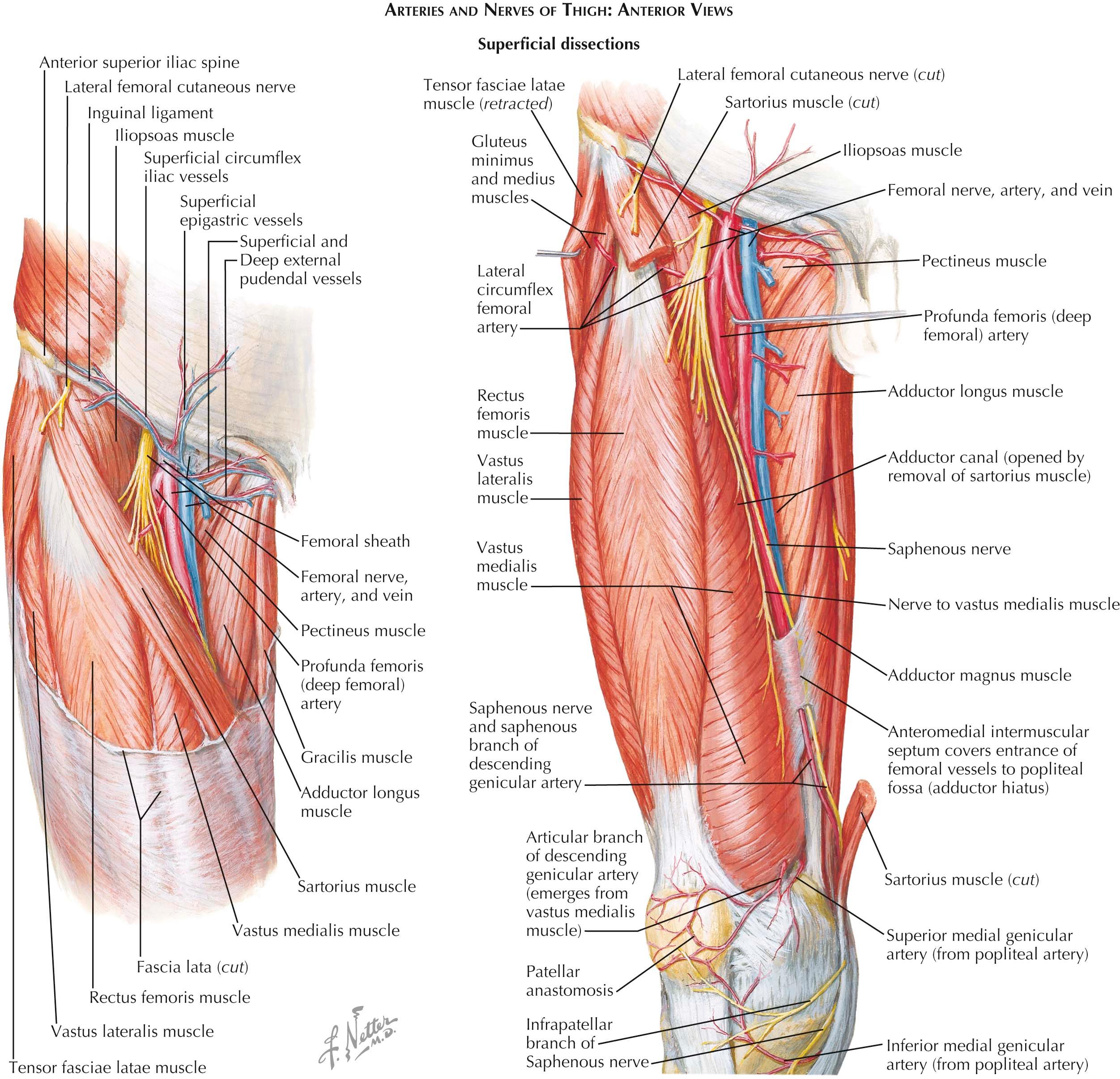
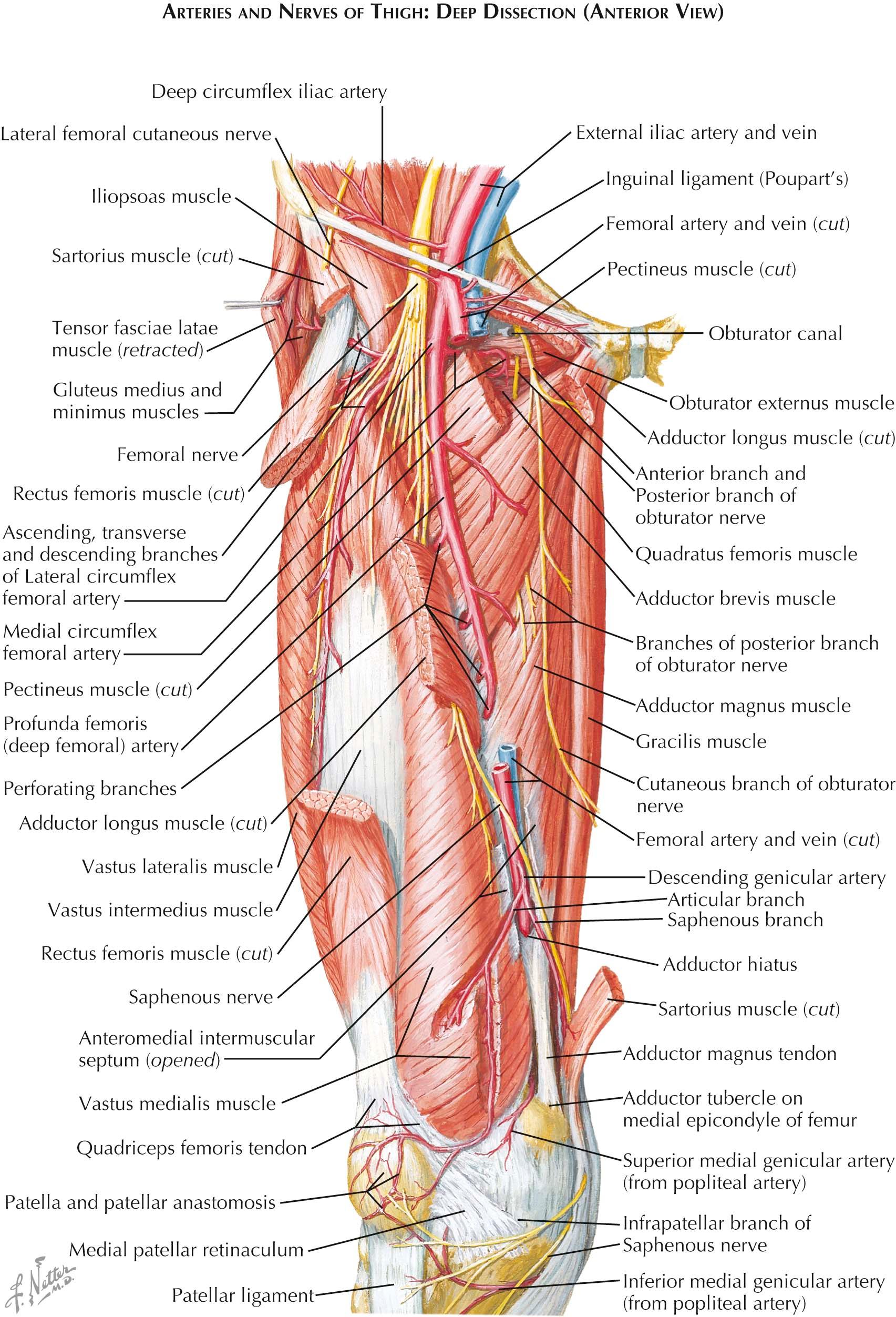
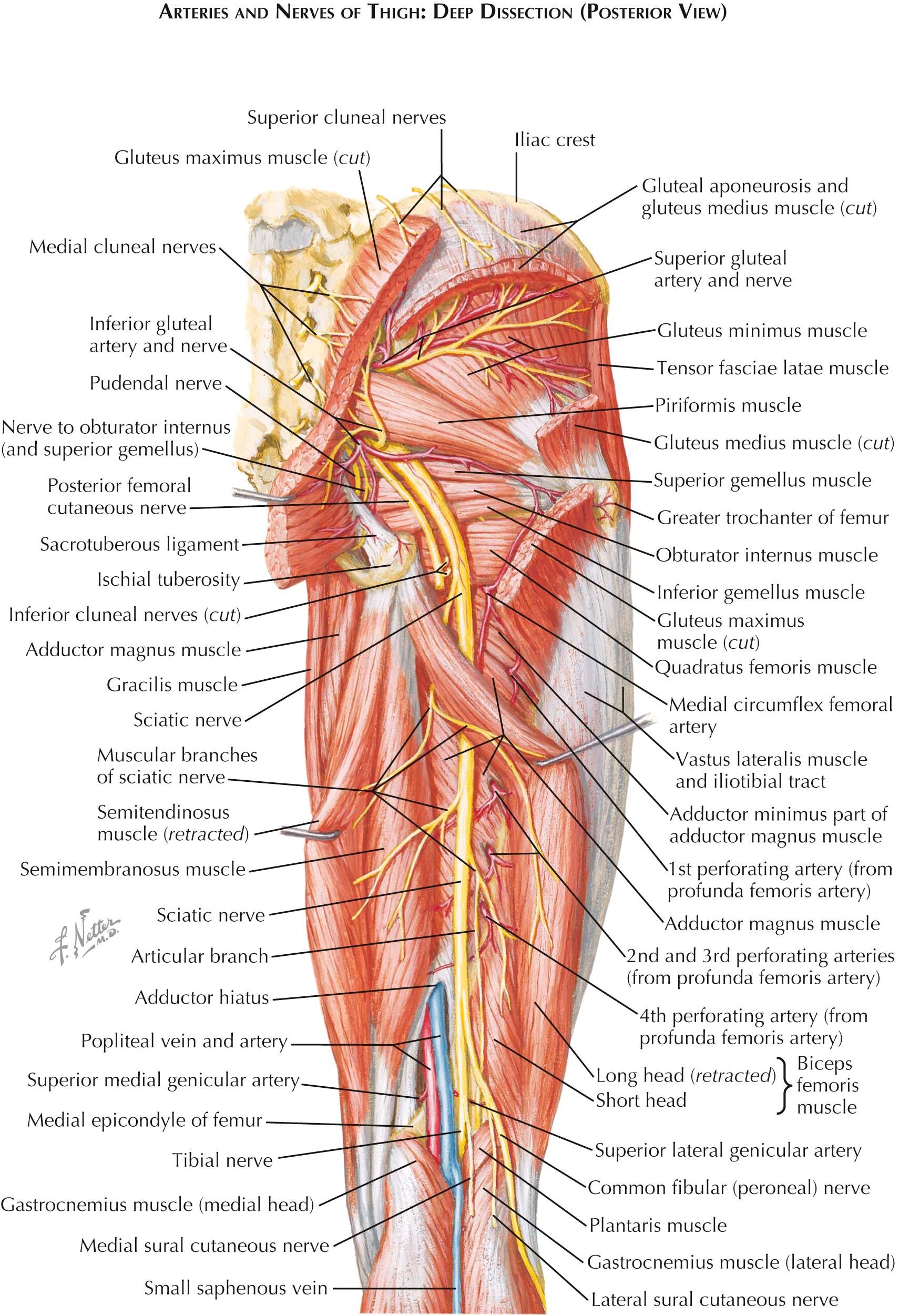
The femoral, obturator, superior gluteal, and inferior gluteal arteries supply the thigh. The former two distribute principally anteriorly; the latter two distribute in the hip region. The femoral artery is the continuation of the external iliac artery. It distributes largely in the femoral triangle and descends through the midregions of the thigh in the adductor canal.
The femoral triangle is a subfascial space in the upper third of the thigh. It is bound by the inguinal ligament above and by the sartorius muscle laterally and the adductor longus muscle medially. The apex of the triangle lies downward; it is formed by the crossing of the sartorius muscle over the adductor longus. The floor of the triangle is also muscular. The borders of the iliopsoas and pectineus muscles bound a deep groove in the floor, and, here, the medial circumflex femoral artery passes to the back of the thigh. The femoral artery enters the adductor canal at the apex of the triangle. The femoral vein lies on the pectineus muscle, medial to the femoral artery; here, it receives the greater saphenous vein. The femoral nerve descends under the inguinal ligament in the groove between the iliacus and psoas major muscles. In the triangle, it divides into most of its muscular and cutaneous branches; only the saphenous nerve and one of the nerves to the vastus medialis muscle continue into the adductor canal.
The femoral artery and vein are covered by the femoral sheath for about 3 cm beyond the inguinal ligament. Here, the extraperitoneal connective tissue of the abdomen extends between the vessels and forms three compartments—a lateral one for the artery, a middle one for the vein, and a medial one for one or more deep inguinal lymph nodes and fat. The medial compartment is known as the femoral canal, and its abdominal opening is the femoral ring.
The adductor canal conducts the femoral vessels and one or two nerves through the middle third of the thigh. It begins about 15 cm below the inguinal ligament at the crossing of the sartorius muscle over the adductor longus muscle and ends at the upper limit of the adductor hiatus, a separation in the tendinous insertion of the adductor magnus muscle that allows the femoral vessels to reach the back of the knee. The canal occupies the middle third of the thigh, and its termination is marked medially by a strong fascial band from the vastus medialis to the adductor magnus muscles—the vastoadductor membrane. As the femoral vessels pass behind the femur to become the popliteal artery and vein, this membrane is perforated by the saphenous nerve and the descending genicular artery.
Branches of the femoral artery are the superficial epigastric, superficial circumflex iliac, superficial external pudendal, deep external pudendal, deep femoral, and descending genicular arteries. The first four branches are primarily related to the lower abdominal wall and the perineum.
The deep femoral artery, the largest branch, arises from the lateral side of the femoral artery about 5 cm below the inguinal ligament. It sinks deeply into the thigh as it descends, lying behind the femoral artery and vein on the medial side of the femur. It crosses the tendon of the adductor brevis muscle and, at its lower border, passes deep to the tendon of the adductor longus muscle. In the lower third of the thigh, the deep femoral artery ends as the fourth perforating artery. In the femoral triangle, this artery gives rise to the medial and lateral circumflex femoral arteries and muscular branches; in the adductor canal, it provides three perforating branches.
The medial circumflex femoral artery springs from the medial and posterior aspect of the deep femoral artery. Its course is deep into the femoral triangle, between the pectineus and iliopsoas muscles and under the neck of the femur to the back of the thigh. Deep to the adductor brevis muscle, an acetabular branch enters the hip joint beneath the transverse ligament of the acetabulum. Several muscular branches supply the adductor brevis and adductor magnus muscles, one distributing with the obturator nerve. Anterior to the quadratus femoris muscle, the artery divides into an ascending branch to the trochanteric fossa of the femur and a descending branch to the hamstring muscles beyond the ischial tuberosity.
The lateral circumflex femoral artery arises from the lateral side of the deep femoral artery, passes lateralward deep to the sartorius and the rectus femoris muscles, and divides into anterior, transverse, and descending branches. The ascending branch passes upward beneath the tensor fasciae latae muscle and anastomoses with terminals of the superior gluteal artery. The small transverse branch enters the vastus lateralis muscle, winds around the femur below its greater trochanter, and anastomoses on the back of the thigh with the medial circumflex femoral, inferior gluteal, and first perforating arteries (cruciate anastomosis). An articular artery for the hip joint may arise from either branch. The descending branch passes on the vastus lateralis muscle, accompanied by a branch of the femoral nerve to this muscle, and anastomoses with the descending genicular branch of the femoral artery and the lateral superior genicular branch of the popliteal artery.
The perforating arteries are usually three in number and arise from the posterior surface of the deep femoral artery. They pass directly against the linea aspera of the femur and pierce the tendons of the adductor muscles to reach the muscles of the posterior compartment of the thigh. The first perforating artery passes immediately below the pectineus and through the middle of the tendon of the adductor brevis muscle; the second, after giving off a nutrient artery to the femur, through its lower 3 or 4 cm; and the third, just below the lowest part of the adductor brevis. The deep femoral artery ends as the fourth perforating artery, which pierces the adductor magnus muscle and largely ends in the short head of the biceps femoris muscle. These vessels anastomose with all the vessels of the back of the thigh.
The descending genicular artery arises from the femoral artery just before the latter passes through the adductor hiatus and immediately divides into saphenous and articular branches. The saphenous branch pierces the vastoadductor membrane and descends between the tendons of the gracilis and sartorius muscles in company with the saphenous nerve, supplying the skin and superficial tissues in the upper medial part of the leg. The articular branch descends in the substance of the vastus medialis muscle to the medial side of the knee. It supplies the vastus medialis muscle, and a branch passes lateralward over the patellar surface to anastomose with all other arteries at the knee joint.
The obturator artery is a branch of the internal iliac artery. It leaves the pelvis via the obturator canal and immediately divides into anterior and posterior branches. These supply the obturator externus and obturator internus muscles and give branches to the adductor brevis and adductor magnus muscles. The posterior branch gives off an acetabular artery, which enters the hip joint through the acetabular notch and provides the small artery of the capitis femoris ligament.
The superior and inferior gluteal arteries are branches of the internal iliac artery. Although arising within the pelvis, they exit immediately into the gluteal region of the thigh. The superior gluteal artery emerges above the piriformis muscle and there divides into a superficial branch to the gluteus maximus muscle and a deep branch to the intermuscular plane between the gluteus medius and gluteus minimus muscles. An upper radicle of this branch supplies the gluteus medius, gluteus minimus, and tensor fasciae latae muscles and reaches as far as the anterior superior iliac spine. A lower radicle is directed toward the greater trochanter of the femur and supplies the gluteal muscles and the hip joint.
The inferior gluteal artery leaves the pelvis below the piriformis muscle and provides large muscular branches to the gluteus maximus muscle and muscles arising from the ischial tuberosity. Small branches pass medially as far as the skin over the coccyx. An anastomotic branch descends across the short lateral rotator muscles of the hip and contributes to the cruciate anastomosis of the back of the thigh. Cutaneous branches accompany radicles of the posterior femoral cutaneous nerve, and an accompanying artery of the sciatic nerve descends on the surface of that nerve. The inferior gluteal artery is long and slender and may reach as far as the lower part of the thigh. It is developmentally the major artery of the lower limb.
In general, the veins of the hip and thigh are venae comitantes of the arteries. The superior and inferior gluteal veins and the obturator vein enter the pelvis with their corresponding arteries; they are tributary to the internal iliac vein. The femoral vein is posterior to the femoral artery at the adductor hiatus but medial to it as it passes under the inguinal ligament to become the external iliac vein. The femoral vein contains two or three bicuspid valves; one is just inferior to the junction with the deep femoral vein, and one is at the level of the inguinal ligament. The superficial circumflex iliac, superficial epigastric, and superficial external pudendal veins enter the greater saphenous and not the femoral vein, and the deep external pudendal vein is usually the highest tributary of the femoral vein. The venae comitantes of the descending genicular artery may enter the lower end of the femoral vein or may end in this vessel at the femoral triangle.
The deep femoral vein enters the femoral vein at a much less regular level than that characterizing the origin of the deep femoral artery (about 8 cm below the inguinal ligament). The perforating veins on the back of the thigh help to form a long anastomotic channel, which is formed by interconnections and connections with tributaries of the popliteal vein below and the inferior gluteal vein above. In three fourths of cases, the medial and lateral circumflex femoral veins empty into the femoral vein rather than into the deep femoral vein and their widespread radicles anastomose with many other veins of the thigh.
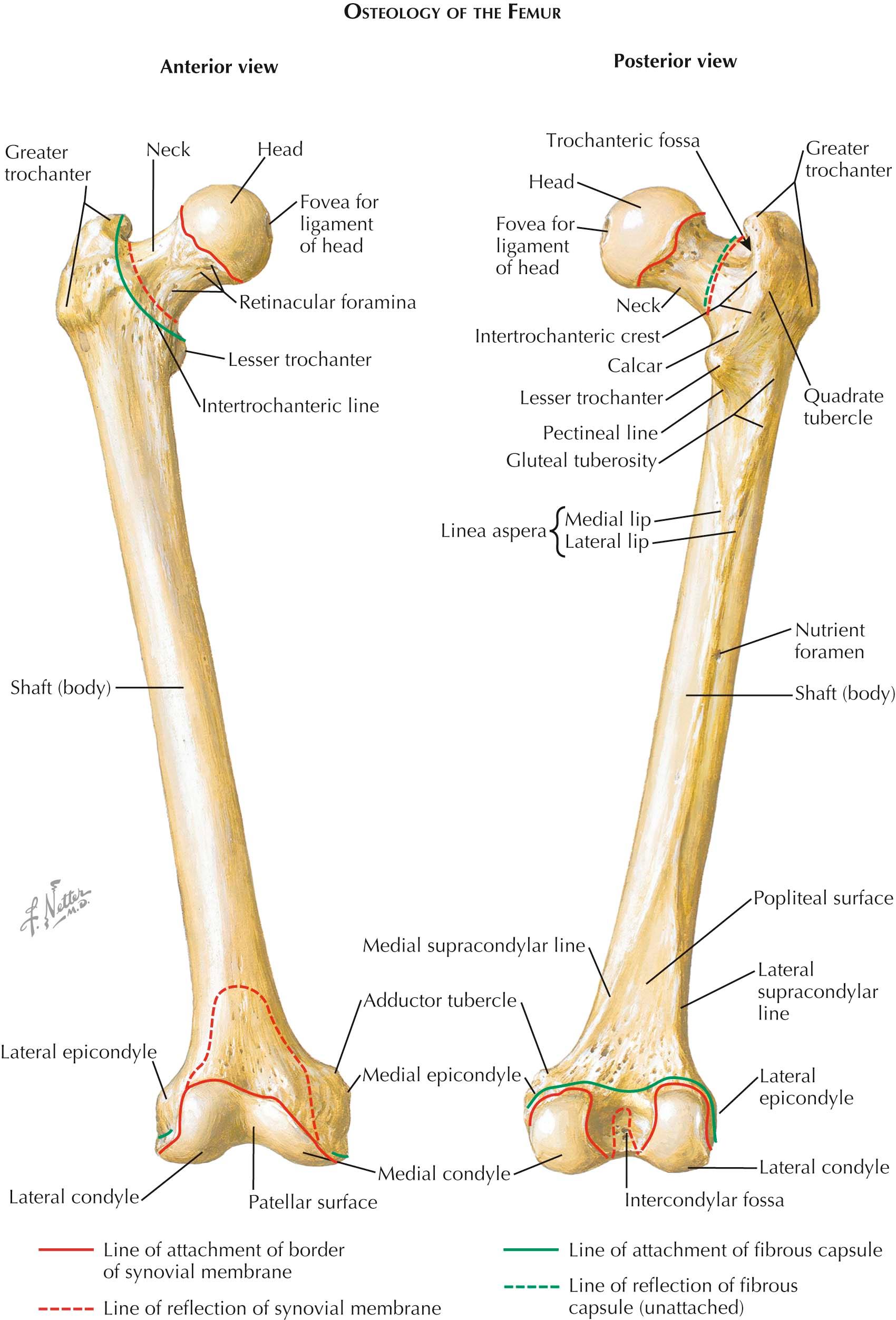
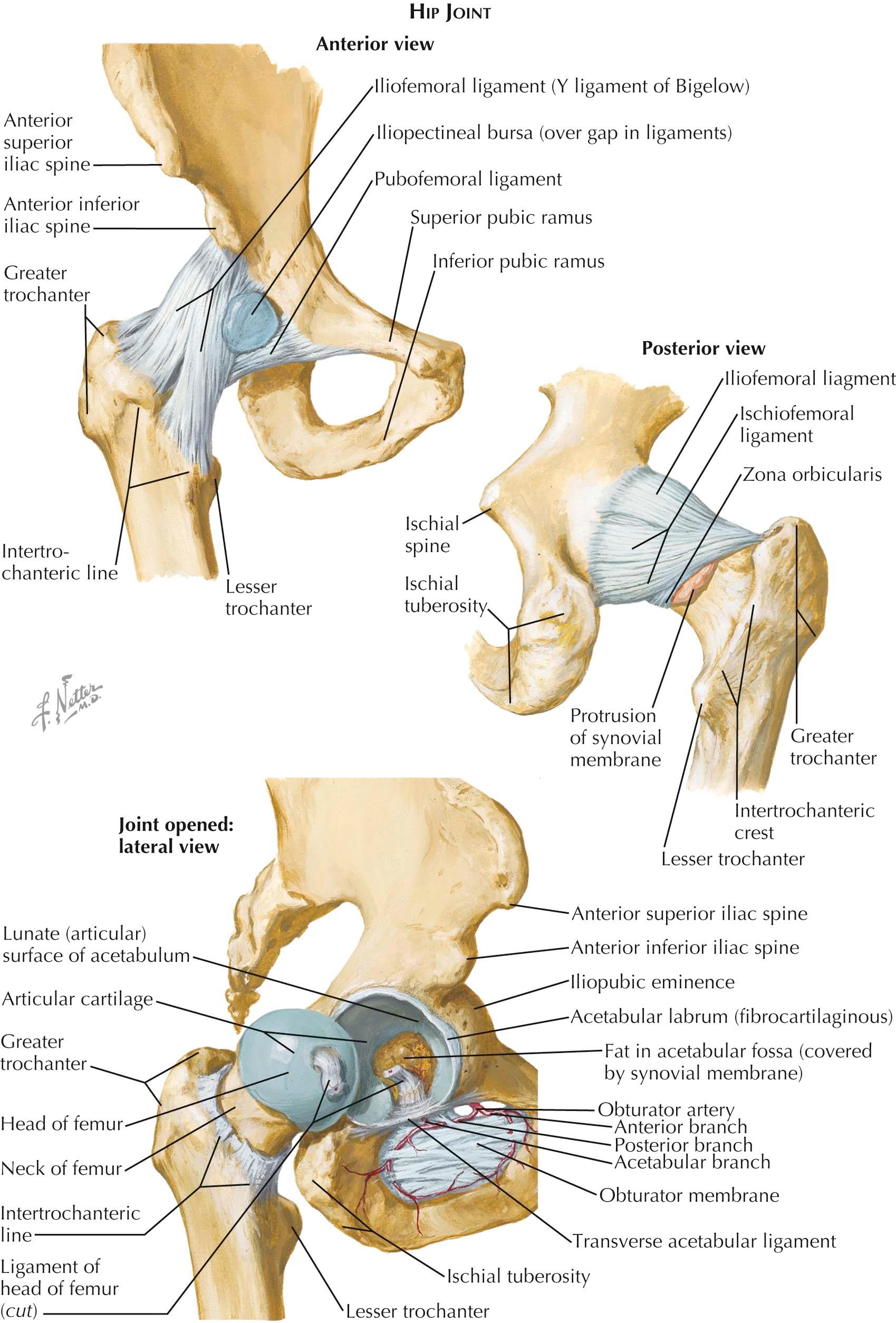
The femur is the longest and strongest bone in the body, comprising a shaft and two irregular extremities that articulate at the hip and knee joints (see Plate 2-19 ).
The superior extremity of the bone has a nearly spherical head mounted on an angulated neck, and prominent trochanters provide for muscular attachments. The head is smooth, with an articular surface that is largest above and anteriorly; this is interrupted medially by a depression, the fovea capitis femoris, into which attaches the capitis femoris ligament.
The neck is about 5 cm long and forms an angle with the shaft, which varies in the normal person from 115 to 140 degrees. It is compressed anteroposteriorly and contains a large number of prominent pits for the entrance of blood vessels.
The greater trochanter is the bony prominence of the hip. It is palpable 12 to 14 cm below the iliac crest, is large and square, and marks the upper end of the shaft of the femur. Its large quadrilateral surface is divided by an oblique ridge running from the posterosuperior to its anteroinferior angles. In front and above the ridge there is a triangular surface (which may be smooth) for a bursa. Below and behind the ridge the bone is also smooth. Its posterior rounded border bounds the trochanteric fossa and continues downward as the intertrochanteric crest. The trochanteric fossa is a deep pit on the internal aspect of the trochanter.
The lesser trochanter is a blunt, conical projection at the junction of the inferior border of the neck with the shaft of the femur. The trochanters are joined behind by the intertrochanteric crest. On the anterior surface of the femur, the junction of the neck and shaft is also ridged. This is the intertrochanteric line, which provides attachment for the capsule of the hip joint across the front of the bone and continues as a spiral line, winding backward to blend into the medial lip of the linea aspera.
The shaft of the bone is fairly uniform in caliber but broadens slightly at its extremities. It is bowed forward and its surface is smooth, except for the thickened ridge along its posterior surface, the linea aspera. This is especially prominent in the middle third of the bone, where lateral and medial lips are developed. Superiorly, the lateral lip blends with the prominent gluteal tuberosity; an intermediate lip extends as the pectineal line to the posterior border of the lesser trochanter; and the medial lip continues as the spiral line. The nutrient foramen of the femur, directed upward, is located on the linea aspera.
The inferior extremity of the femur is broadened about threefold for the knee joint. Its surfaces, except at the sides, are articular—two oblong condyles for articulation with the tibia are separated by an intercondylar fossa and united anteriorly by the patellar surface. The wheel-like condyles are also curved from side to side. The intercondylar fossa is especially deep posteriorly and is separated by a ridge from the popliteal surface of the femur above. The medial condyle is longer than the lateral condyle. The condyles rest on the horizontal condyles of the tibia, and the shaft of the femur inclines downward and inward.
The epicondyles bulge above and within the curvatures of the condyles. The medial epicondyle is the more prominent, giving attachment to the tibial collateral ligament of the knee joint. It bears on its upper surface a pointed projection, the adductor tubercle. The lateral epicondyle gives rise to the fibular collateral ligament. A groove below the epicondyle borders the articular margin.
The femur is ossified from five centers: one for the shaft, one each for the head and inferior extremity, and one for each trochanter. The shaft is ossified at birth; ossification extends into the neck after birth. The center for the inferior extremity of the bone appears during the ninth month of fetal life; that for the head appears during the first year. The center in the greater trochanter appears during ages 3 to 5; that for the lesser trochanter appears at age 9 or 10. The epiphyses for the head and trochanters fuse with the shaft at ages 14 to 17; those at the knee fuse with the shaft at about age  in boys but by age 15 in girls.
in boys but by age 15 in girls.
Movements of the hip joint are flexion-extension, abduction-adduction, and medial and lateral rotation. Circumduction is also allowed.
The hip joint, a synovial ball-and-socket joint, consists of the articulation of the globular head of the femur in the cuplike acetabulum of the coxal bone (see Plate 2-20 ). Compared with the shoulder joint, it has greater stability and some decrease in freedom of movement. The head forms about two thirds of a sphere and is covered by articular cartilage, thickest above and thinning to an irregular line of termination at the junction of the head and neck. The acetabulum of the coxal bone exhibits a horseshoe-shaped articular surface arching around the acetabular fossa. The articular fossa lodges a mass of fat covered by synovial membrane; the transverse ligament of the acetabulum closes the fossa below. An acetabular labrum attaches to the bony rim and to the ligament. It attaches to the bony rim and to the ligament. Its thin, free edge cups around the head of the femur and holds it firmly.
The articular capsule of the joint is strong. It is attached to the bony rim of the acetabulum above and to the transverse ligament of the acetabulum inferiorly. On the femur, it is attached anteriorly to the intertrochanteric line and to the junction of the neck of the femur and its trochanters. Behind, the capsule has an arched free border, covering only two thirds of the neck of the femur distally. Most of the fibers of the capsule are longitudinal, running from the coxal bone to the femur, but some deeper fibers run circularly. These zona orbicularis fibers are most marked in the posterior part of the capsule; they help to hold the head of the femur in the acetabulum.
Three ligaments, as thickenings of the capsule, add strength. The very strong iliofemoral ligament lies on the anterior surface of the capsule, in the form of an inverted Y . Its stem is attached to the lower part of the anterior inferior iliac spine, with the diverging bands attaching below to the whole length of the intertrochanteric line. The iliofemoral ligament becomes taut in full extension of the femur and thus helps to maintain erect posture, because in this position the body's weight tends to roll the pelvis backward on the femoral heads. The pubofemoral ligament is applied to the medial and inferior part of the capsule. Arising from the pubic part of the acetabulum and the obturator crest of the superior ramus of the pubis, this ligament reaches the underside of the neck of the femur and the iliofemoral ligament. The ligament becomes taut in extension and also limits abduction. The articular capsule is thinnest between the iliofemoral and pubofemoral ligaments but is crossed here by the robust iliopsoas tendon. The iliopectineal bursa lies between this tendon and the capsule. The ischiofemoral ligament forms the posterior margin of the capsule. It arises from the ischial portion of the acetabulum and spirals lateralward and upward, ending in the superior part of the femoral neck. The capitis femoris ligament, about 3.5 cm long, is intracapsular, arising from the two margins of the acetabular notch and the lower border of the transverse acetabular ligament and ending in the fossa of the head of the femur. It becomes taut in adduction of the femur.
The synovial membrane of the hip joint lines the articular capsule, covers the acetabular labrum, and is extended, sleevelike, over the ligament of the head of the femur. The membrane covers the fat of the acetabular notch and is reflected back along the femoral neck at the femoral attachment of the capsule. Blood vessels to the head and neck of the femur course under these synovial reflections.
The arteries of the hip joint are branches of the medial and lateral circumflex femoral arteries, the deep branch of the superior gluteal artery, and the inferior gluteal artery. The posterior branch of the obturator artery provides a significant portion of the blood supply of the femoral head. Nerve supply to the hip joint is derived from the nerves supplying the quadratus femoris and rectus femoris muscles, the anterior division of the obturator nerve (rarely also from the accessory obturator nerve), and the superior gluteal nerve.
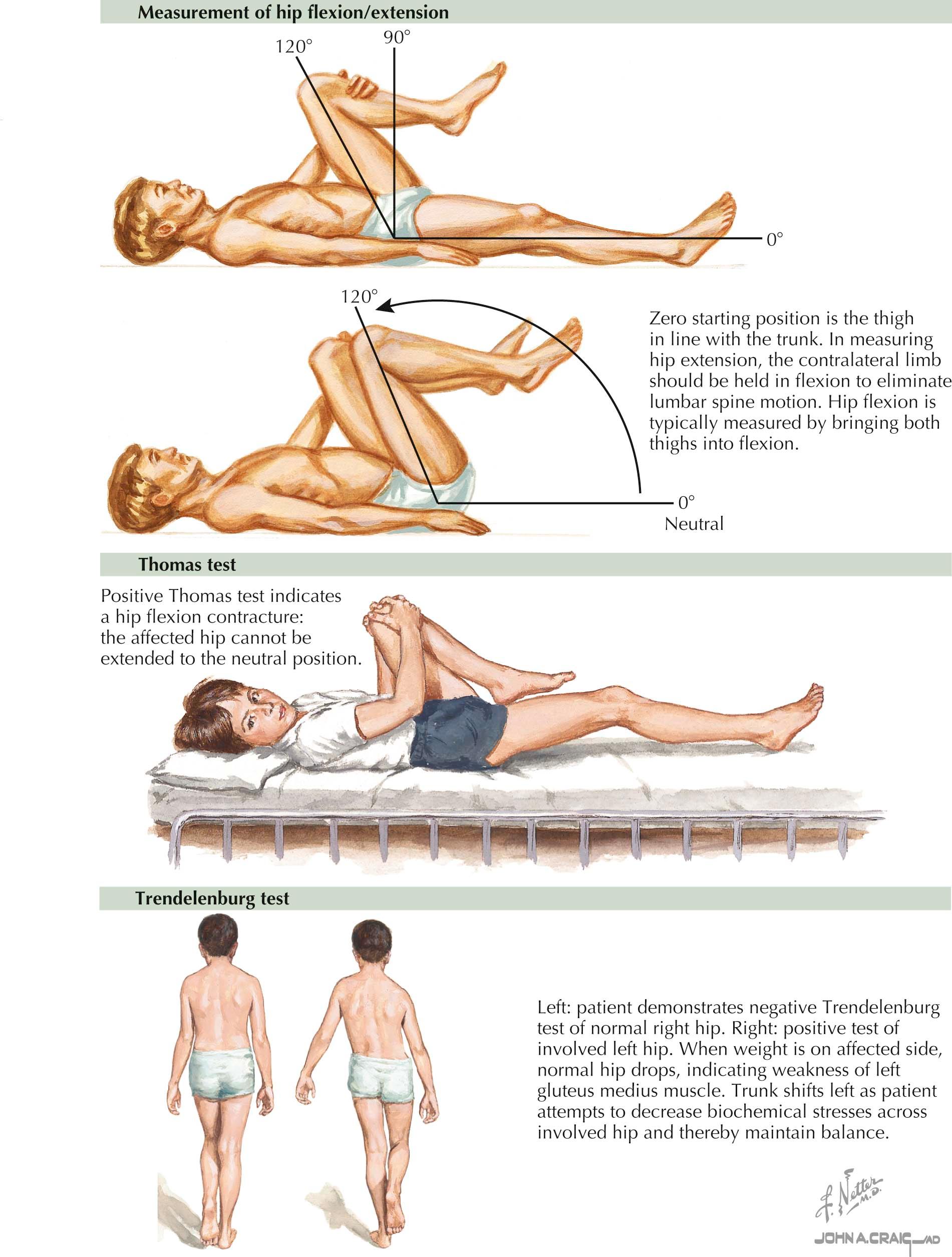
Physical examination of the hip is initiated with observation of the patient. Specific note is made of body habitus. Gait is evaluated directly, looking for a Trendelenburg or antalgic gait that favors the affected side. Both gait patterns are associated with intra-articular and extra-articular hip pathologic processes.
The patient is then placed supine on an examination table, and landmarks are palpated. These landmarks include the anterior superior iliac spine, iliac crest, pubic symphysis, pubic tubercles, and proximal adductor tendons. The abdomen may also be palpated in this position if there is concern about any abdominal disorder.
Range of motion of the hips is then evaluated. This may be also examined combined with the upright and prone position based on the preference of the examiner. First checked is hip flexion, followed by internal and external rotation with the hip flexed to 90 degrees. In full extension, the hip is taken into adduction as well as abduction. Straight-leg hip flexion can also be evaluated for hamstring tightness or radicular low back pain. Deficits or painful ranges are noted compared with the contralateral/unaffected side. Specific tests for the hip joint in this position include the anterior impingement test (flexion/adduction/internal rotation), which is commonly painful in the face of labral tears or osteoarthritis. The hip may also to be placed in the figure-4 position, looking for pain or a loss of motion that may also indicate intra-articular findings. Straight-leg raising is performed to evaluate hip flexion strength in the supine position. Resisted adduction is also tested in the supine position to evaluate strength and integrity of the adductors.
The patient is then placed in the lateral decubitus position, and both the affected and nonpainful side are evaluated. Palpation is begun over the greater trochanter (trochanteric bursa posterior/superiorly), the gluteus medius/minimus tendons just proximal to the tip of the trochanter, and the piriformis tendon at the proximal/posterior aspect of the trochanter just posterior to the abductor musculature. The iliotibial band is checked for tightness with the Ober test. Hip abduction strength is evaluated with the hip held in the abducted position against resistance.
A prone examination is then completed. Examination of the hamstrings is best completed in this position, as well as palpation of the ischial tuberosity and proximal hamstring insertion and muscle bellies. Hamstring strength is tested with resisted knee flexion at 90 and 45 degrees. The Thomas test is useful to look for hip flexion contracture while the patient is in this position.
Completion of the hip examination is then done in the upright position. Palpation of the posterior iliac crest and posterior superior iliac spine/sacroiliac joint is completed at this point. This position also allows for palpation of the midline and paraspinal lumbar spine. Hip flexion strength in this position isolates the iliopsoas unit.
The joint proximal (lumbar spine) and distal (knee) are also evaluated for completeness and to rule out referred pain. This may also be inferred from good history taking.
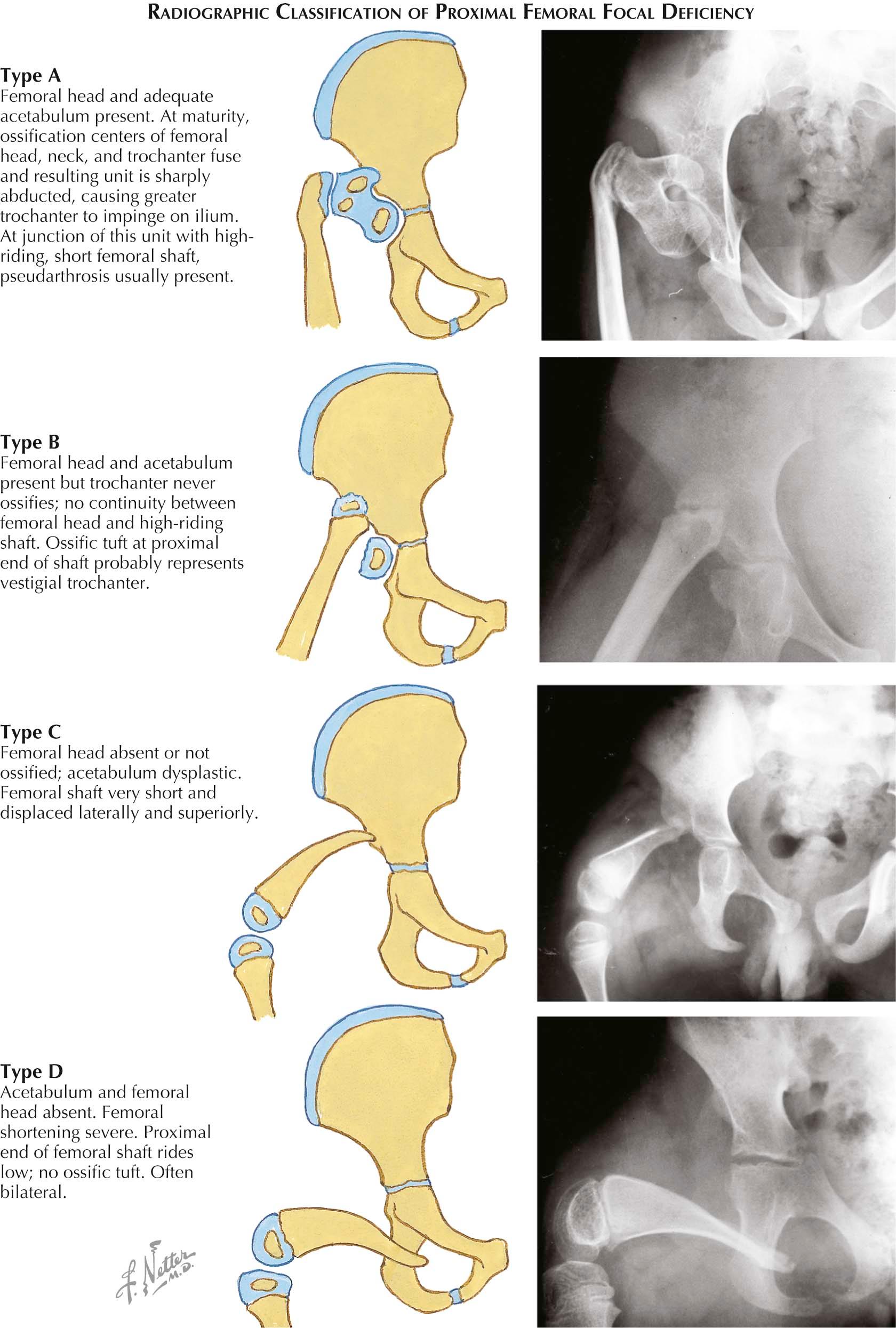
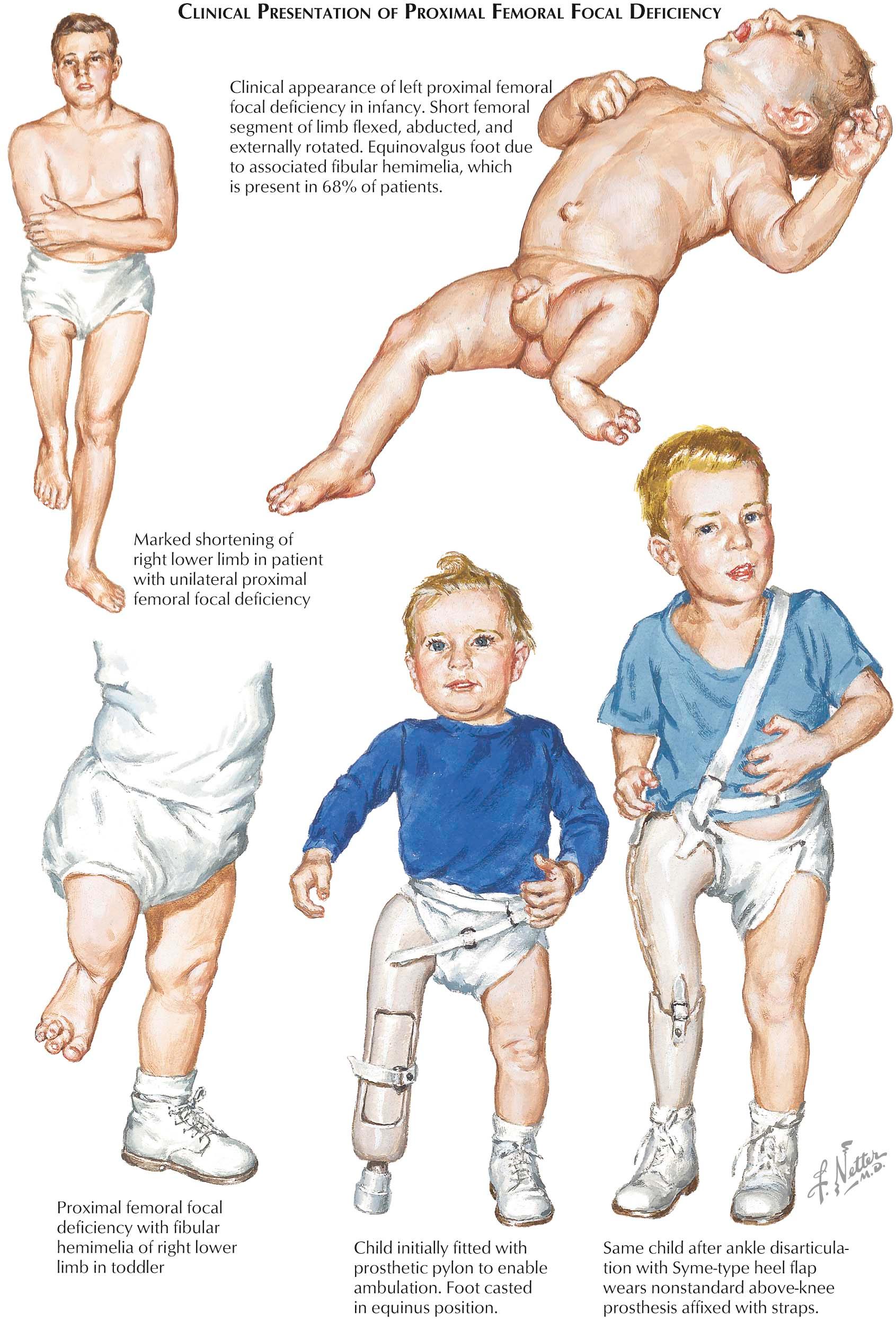
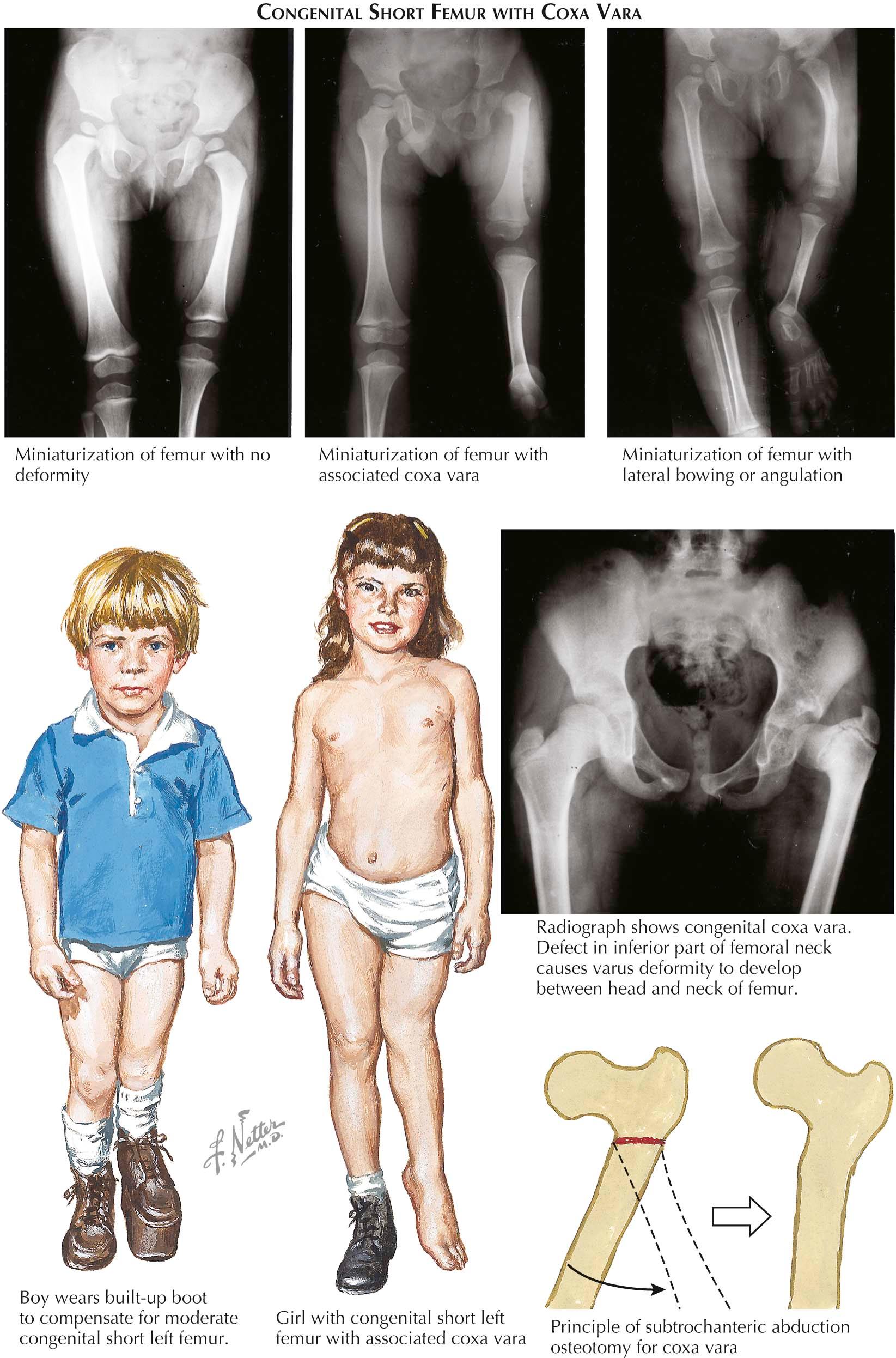
Proximal femoral focal deficiency is a randomly occurring congenital abnormality of the proximal femur and hip joint. It is usually unilateral and in 68% of patients is accompanied by fibular hemimelia on the ipsilateral side. About 50% of the patients have skeletal abnormalities of other limbs as well. Based on results of a large radiographic survey, proximal femoral focal deficiency has been classified into four types, according to the type and severity of the femoral and acetabular defects (see Plate 2-22 ).
Clinical Manifestations. Regardless of the extent of the anatomic defect, the clinical manifestations of proximal femoral focal deficiency are quite consistent (see Plate 2-23 ). The affected limb is held in varying degrees of flexion, abduction, and external rotation at the hip. The femoral segment of the limb is much shorter than the normal femur. In the patient with concomitant fibular hemimelia, the sole of the foot on the affected side is usually level with the knee joint on the unaffected side. Soft tissue contracture about the hip and some flexion contracture in the knee are also evident.
These deformities result in a number of biomechanical problems: (1) leg-length discrepancy, (2) malrotation, (3) inadequacy of the proximal musculature, and (4) instability of the hip joint.
In patients with unilateral involvement, the unequal leg lengths obviously hinder bipedal ambulation. In patients with bilateral involvement, symmetric leg-length discrepancy results in a striking disproportionate dwarfism.
Radiographic Findings. The radiographic appearance of proximal femoral focal deficiency varies considerably according to the extent of the anatomic defects (see Plate 2-22 ). The major diagnostic problem is differentiating proximal femoral focal deficiency types A and B from congenital short femur associated with coxa vara (see Plate 2-24 ). For both conditions, radiographs taken in infancy are difficult to interpret. If the diagnosis is uncertain, treatment should be postponed until the specific deformity is conclusively demonstrated on serial radiographs.
Treatment. In formulating a management plan for this complex deformity, it is important to establish early realistic goals for rehabilitation. The primary aim is to facilitate bipedal ambulation. Although correction of the flexion, abduction, and external rotation of the hip is desirable, it is not always possible. Both nonsurgical and surgical methods are used to help compensate for instability of the hip joint and inadequacy of the hip musculature.
In the past, crutches were the only aid for patients with unilateral involvement, and persons with disproportionate dwarfism simply ambulated on their own malformed lower limbs. Later, orthoses such as shoe lifts were devised to compensate for leg-length discrepancy and allow some degree of unassisted ambulation. More recently, nonstandard prostheses have been designed that better equalize limb lengths and improve gait. In some patients, amputation facilitates the application and improves the comfort of these prostheses.
Three general treatment options are available for patients with unilateral involvement. The first is to fabricate a prosthesis that fits around the deformity. The design of the device is limited only by the ingenuity of the prosthetist. The second option is to consider the deformity as a homologue of an above-knee amputation and to devise the equivalent of an above-knee prosthesis that accommodates the deformity. The third option is to consider the deformity as the equivalent of a below-knee amputation and to design a suitable prosthesis (see Plate 2-23 ).
Treatment of the deformity as an above-knee amputation is facilitated by removing the foot. The surgical procedure, which consists of ankle disarticulation and Syme-type closure with the heel flap, produces a suitable end-bearing stump.
If the deformity is treated as a below-knee amputation, surgical conversion is necessary. A 180-degree Van Ness rotational osteotomy of the tibia is performed so that the retained ankle joint functions as a knee joint and the remaining foot becomes the below-knee residual limb.
The patient with a bilateral condition—whose primary problem is disproportionate dwarfism—should be treated with bilateral extension prostheses that fit around the deformities. The prostheses, which are lengthened as needed to establish peer height, make the patient a precarious “stilt walker.” Many patients learn to ambulate quite competently on these stilts with the assistance of a cane or crutches.
Conversion of bilateral deformities to above-knee or below-knee amputations is not recommended because patients with bilateral involvement can ambulate without assistance. Bilateral Syme amputations and rotational osteotomies may rob the patient of this ability.
When the deformity is treated as a below-knee or above-knee amputation, surgical stabilization of the hip improves gait characteristics. However, establishing a stable valgus relationship between the head of the femur and the diaphysis is possible only in types A and B, which have a competent acetabulum, a femoral head that eventually ossifies, and a congruent relationship between the femoral head and the acetabulum. Thus, hip reconstruction is indicated in types A and B only. Other surgical modalities to promote a more stable hip (e.g., fusing the femur to the ilium and using the knee joint as a hip joint) have not improved patient rehabilitation.
Arthrodesis of the knee is useful in selected patients. If a unilateral deformity is converted to an end-bearing, above-knee stump, knee arthrodesis overcomes any residual knee flexion deformity. This technique is also beneficial in a unilateral deformity considered as a below-knee amputation. Thus, if the rotational osteotomy is successful, the child may be fitted with a standard below-knee prosthesis that is secured with a thigh corset (and knee joints), without the need to use other types of auxiliary suspension such as a suction socket.
Congenital short femur is classified into three distinct types: (1) miniaturization of the femur without other deformity, (2) miniaturization of the femur with coxa vara, and (3) miniaturization with lateral bowing or angulation of the femur (see Plate 2-24 ).
Coxa vara is an abnormality of the proximal femur characterized by a neck-diaphysis angle of less than 120 degrees. Causes are multiple. Although it is often congenital, it may also result from a metabolic aberration or trauma. Coxa vara is associated with several types of generalized skeletal abnormalities and often accompanies congenital short femur.
Clinical Manifestations. Leg-length discrepancy is the major deformity in short femur with coxa vara. Unlike proximal femoral focal deficiency, there is no flexion, abduction, and external rotation deformity of the hip. However, fibular hemimelia with a moderately severe valgus deformity of the ankle may also be present on the affected side, exacerbating the leg-length discrepancy.
Radiographic Findings. Radiographs of congenital short femur with associated coxa vara usually show the proximal end of the femoral diaphysis in bony continuity with the femoral head and neck, and the proximal end of the femur does not ride above Hilgenreiner's line. On the other hand, in proximal femoral focal deficiency types A and B, the proximal femur usually rides above the superior rim of the acetabulum; this finding is a useful factor in the differential diagnosis (see Plate 2-22 ).
Treatment. Management of a deformity of this magnitude requires a team of specialists, including a physician interested in such problems, an experienced prosthetist, and a skilled physical therapist, to collectively evaluate the problem and select the most appropriate treatment modalities. It is most important to describe to the patient and the family the overall management plan that will result in maximal function.
Coxa vara should be treated as soon as the diagnosis is certain. The primary goal is to establish a stable valgus relationship between the diaphysis and the head and neck of the femur. Subtrochanteric osteotomy is performed to produce a position of maximum valgus, not simply to restore the neck-diaphysis angle to greater than 120 degrees. (This procedure is not appropriate for proximal femoral focal deficiency.) Any incompetence of the acetabulum on the affected side should be treated with appropriate hip reconstruction techniques.
Treatment of the combined deformities of short femur and coxa vara varies. Because the major defect is leg-length discrepancy primarily owing to the short femur and concomitant fibular hemimelia, it is usually difficult to equalize the levels of the knees. Shoe lifts to accommodate for the unequal limb lengths are successful in some patients. The Syme amputation, which produces an end-bearing below-knee stump, permits the use of a below-knee prosthesis; in many patients, this result is both more cosmetic and possibly more functional than a simple shoe lift with or without an orthotic device. Some children with stable hips and knees may be candidates for leg-lengthening procedures.
The use of shoe lifts and conversion to a below-knee amputation does not equalize the levels of the knees, however. This can be accomplished by an end-bearing above-knee amputation. In this procedure, a portion of the tibia is fused to the femur and the amputation is done at a level that matches the contralateral normal knee joint.
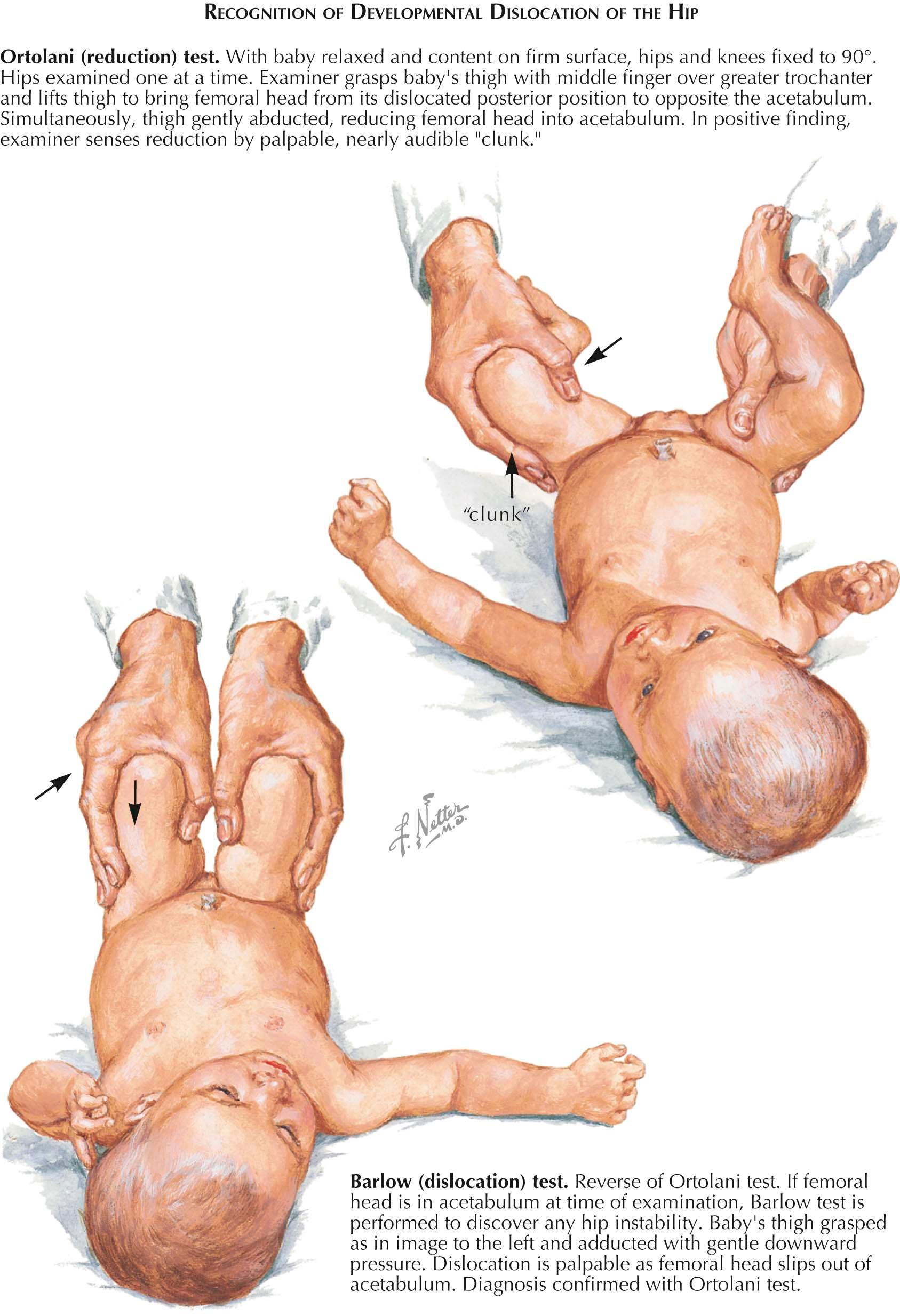
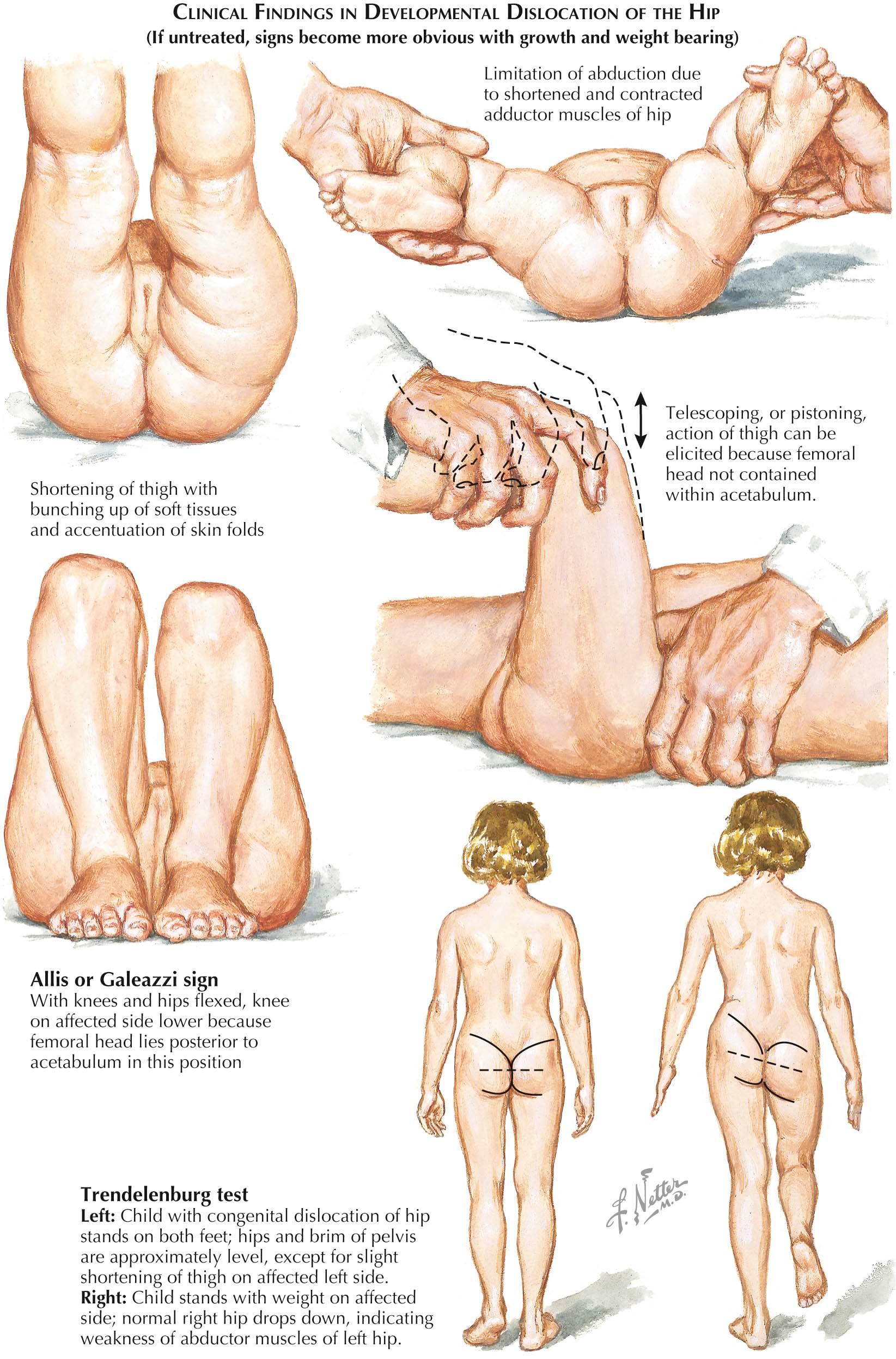
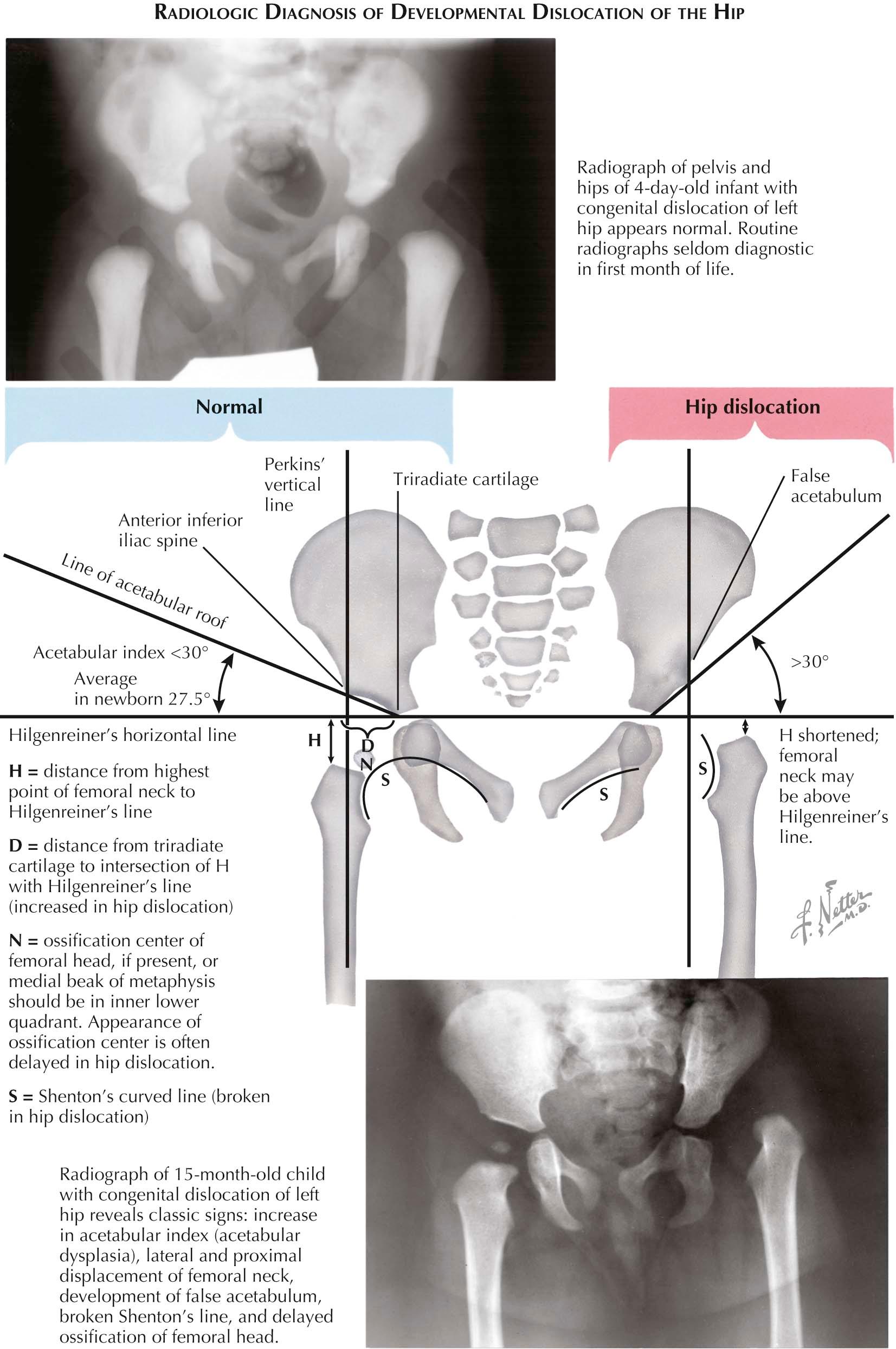
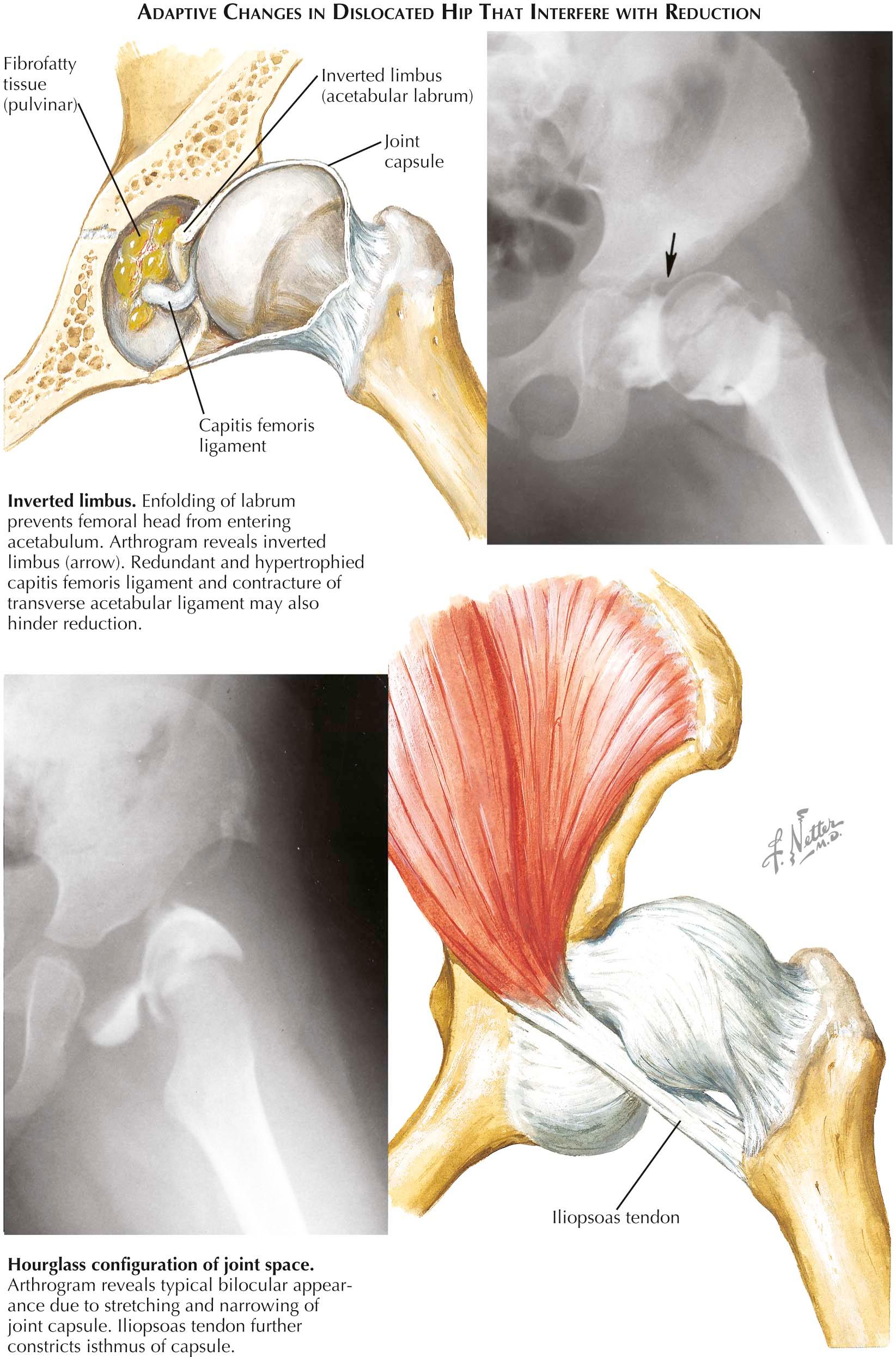
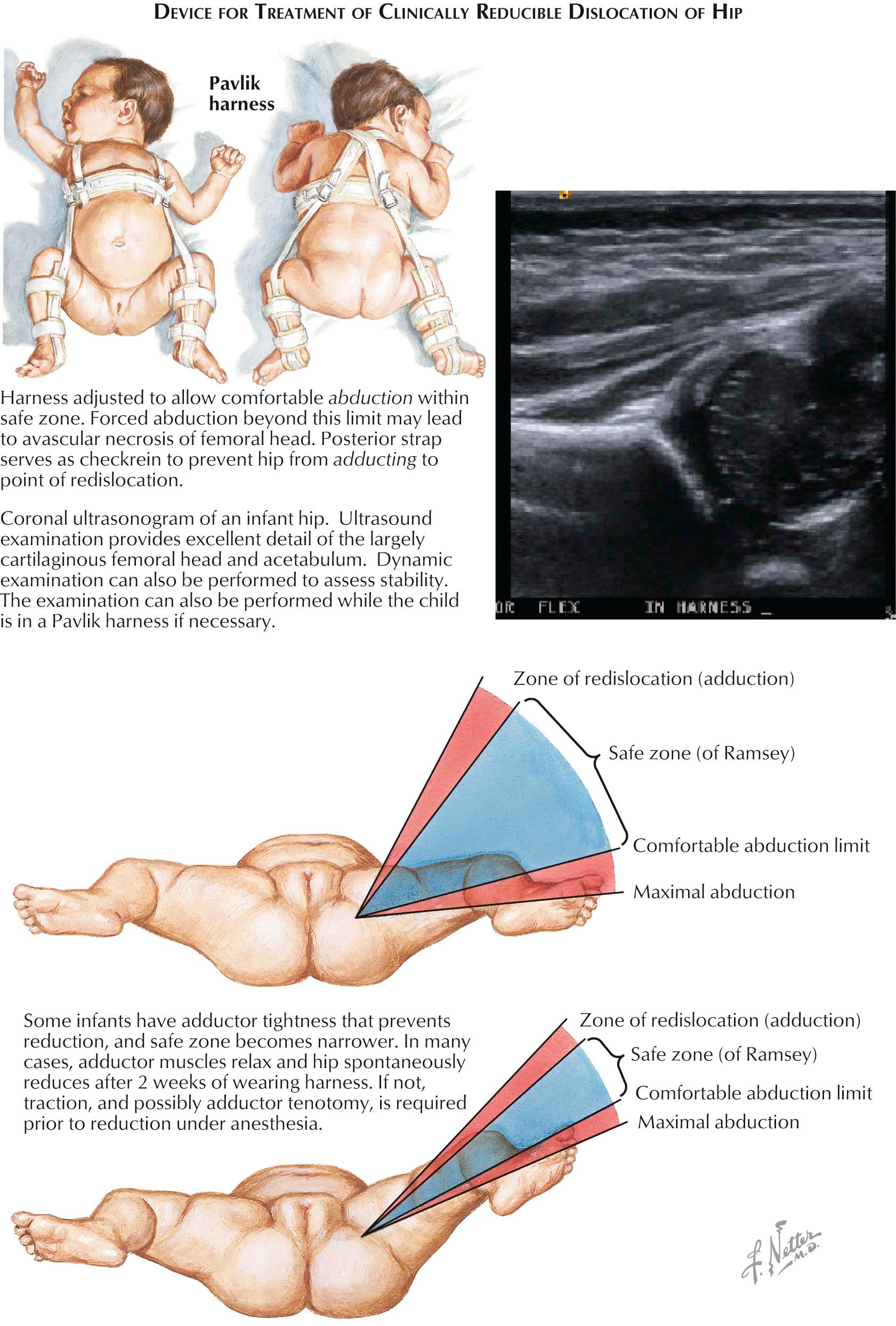
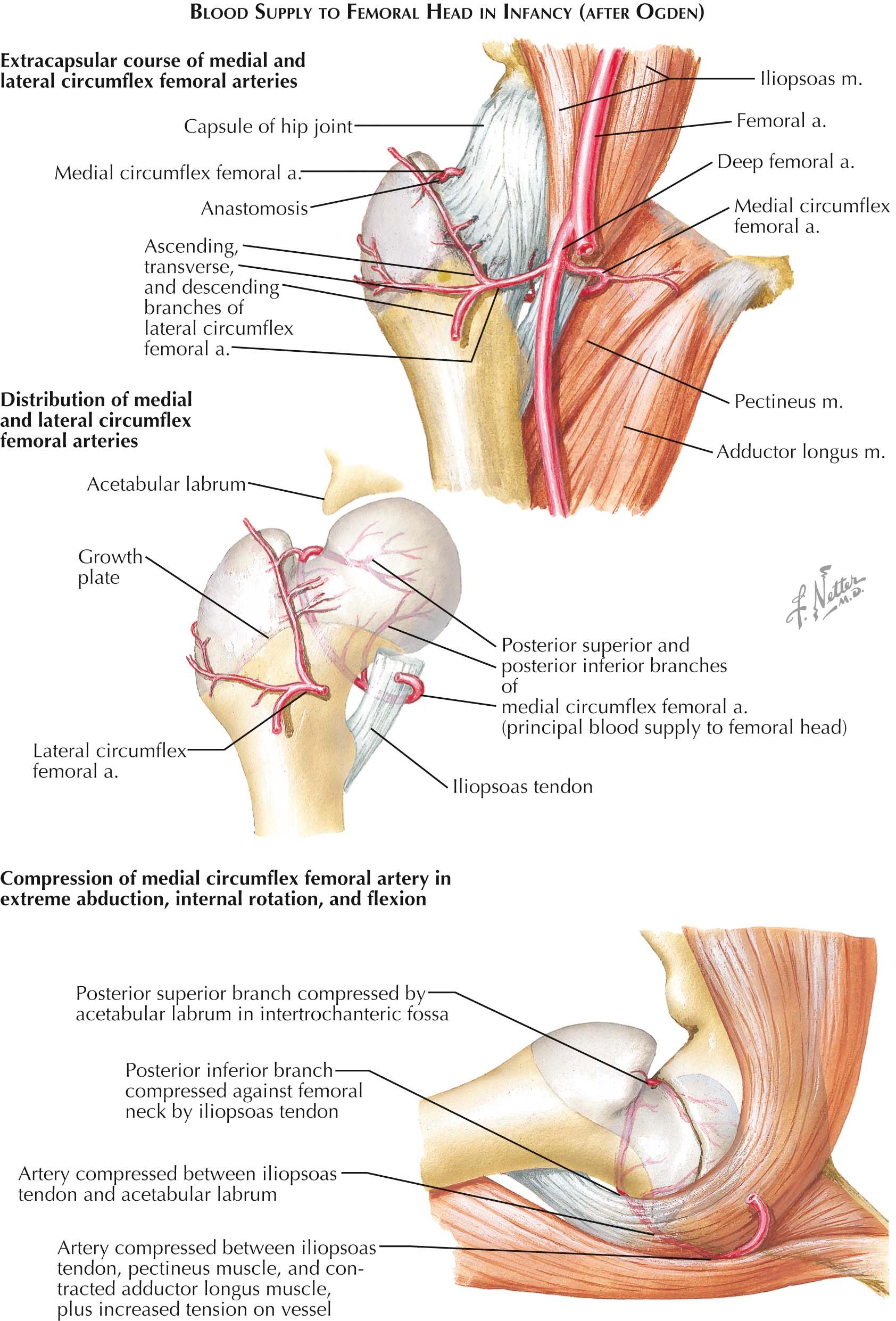
Methods for the early detection of developmental dislocation of the hip (DDH) have been reported for nearly 100 years. The first screening program in the United States was described and initiated in the 1930s. After World War II, extensive screening programs in the United States, Sweden, and England resulted in the early identification and, ultimately, the simple, effective, and safe treatment protocols.
In the United States, approximately 10 in 1000 infants are born with DDH. As a result of screening programs, 96% of these children have normal hip function. The longer the dislocation goes untreated, the more difficult it is to obtain a satisfactory result. Routine screening for this entity should be an integral part of newborn well-child care.
The etiology of DDH remains multifactorial. Mechanical and physiologic properties of both the mother and infant have been implicated, combining to produce instability and, ultimately, dislocation.
The time at onset of instability affects the severity of the condition. The typical developmental dislocation develops just before delivery in an otherwise normal infant. At birth, the clinical findings are often subtle and radiographs are usually normal. In contrast, if the dislocation occurs early in gestation, the clinical and radiographic findings are more severe with advanced adaptive changes in the femoral head and pelvis. This is often termed teratologic dislocation and is typically found in patients with underlying conditions such as arthrogryposis, chromosomal abnormalities, and other severe congenital anomalies such as spina bifida and lumbosacral agenesis. Teratologic dislocations occur in less than 2% of patients with DDH.
Mechanical factors most likely occur in the last trimester of pregnancy. All have the effect of restricting intrauterine space for the fetus, also termed packaging. Roughly 60% of infants with DDH are firstborns, suggesting that the tight unstretched uterus and abdominal wall inhibit fetal movement. It is believed that the fetal pelvis becomes trapped within the maternal pelvis, not allowing the normal flexion of the fetal hip and knee.
Breech presentation also plays a significant role in DDH. Thirty to 50 percent of affected children are delivered in breech presentation. When the knees are extended in the frank breech position, excessive hamstring stretch contributes further to hip laxity and instability. DDH is seen more frequently in children with congenital knee dislocation or recurvatum, as well as other packaging phenomena such as metatarsus adductus and congenital muscular torticollis.
The left hip is more commonly involved than the right, in theory because the left hip is trapped against the maternal sacrum in the most frequent presenting position—left occiput anterior. The maternal sacrum forces the left hip into flexion and adduction, contributing to instability and, ultimately, DDH. In this position, the femoral head is covered more by the joint capsule than the acetabulum proper.
Maternal estrogens and other hormones that affect relaxation of the pelvis right before delivery also affect the fetal hip. Their presence may lead to temporary laxity in the hip joint in the fetus and newborn. Studies suggest that the female infant is more affected by these hormones, which may explain the higher incidence of DDH (6 : 1) in females.
Up to 20% of cases are deemed familial. This may be due to an inborn or possibly an inherited error of estrogen metabolism and may explain the higher rates of familial disease in Northern Italians, Scandinavians, and some Navajo tribes.
In the first months of life, normal hip position is that of abduction and flexion. In cultures in which swaddling of infants places the hips in positions of extension and adduction, there is a 10-fold increase in DDH rates. The practice of holding the child by the feet in the newborn period places the hips in extension and should be avoided.
The pathogenesis of a typical developmentally dislocated hip is probably quite simple. Near the time of delivery, the joint capsule is likely distended and elastic. After delivery, the femoral head is free to move about the distended lax capsule and can come in and out of the acetabulum freely. In newborns, the femoral head can easily be returned to the normal position. At this stage, the soft tissue structures and joint surfaces are essentially normal and therefore the capacity to develop a normal hip exists. Therefore, for a stable hip to develop, the femoral head needs to stay in contact with the acetabulum as the joint capsule loses its laxity and returns to a normal configuration. However, if the dislocation is allowed to persist, the capsule, joint, and other soft tissue go through a series of adaptive changes. This makes the dislocation more difficult to reduce, and the chance of obtaining a satisfactory long-term result diminishes significantly.
It has been demonstrated that the stimulus for development of a normal acetabulum is the presence of a normal femoral head within the acetabulum. Conversely, a normal femoral head will develop if it is contained within a normal acetabulum. Because the infant grows so rapidly in the first year of life (tripling in size in the first 12 months), there is tremendous remodeling potential in this period to convert pathologic changes to normal anatomy.
If the dislocation is not treated, the initially simple problem becomes more complex. Persistent dislocation is met with normal muscle forces causing proximal and lateral migration of the femoral head. The iliopsoas, adductors, and hamstrings do not exist at their normal resting length and become contracted. The acetabulum becomes dysplastic (more shallow) without the stimulus of the femoral head. Fibrofatty tissue termed pulvinar develops within the joint. The ligamentum teres becomes thickened, and the transverse acetabular ligament becomes taught and migrates superiorly into the joint. The joint capsule balloons anteriorly and becomes redundant. The tight iliopsoas tendon compresses the joint capsule, trapping the femoral head outside the acetabulum blocking reduction of the joint. This creates an hourglass configuration of the joint space. Undue pressure on the labrum causes it to enlarge and sometimes invert into the joint, preventing reduction and thus it is termed an inverted limbus.
The femoral head becomes misshapen and flattened as it articulates with the outer table of the pelvis. The normal femoral rotation is blocked, and the femoral head and neck stay in a position of relative anteversion and valgus.
The examination procedures described by Ortolani and Barlow are the most reliable methods of making the diagnosis of DDH in the neonate (see Plate 2-25 ). The Ortolani test is a test of hip reduction. If the infant's hip is dislocated, then it can be reduced with this maneuver, which is also termed an Ortolani positive hip. The Barlow test demonstrates the reverse. Gentle flexion and adduction of the infant's hip produces a painless clunk of dislocation, indicating an unstable joint. Over time, if instability is allowed to persist, these findings go away and the only reliable finding is limited abduction.
Based on the variability of the clinical findings, there exists a spectrum of disease in DDH. The least severe form is simple dysplasia with stable hip joints, followed by a Barlow positive hip (reduced but dislocatable), then an Ortolani positive hip (dislocated but reducible), and finally teratologic or unreducible hips. This spectrum is best illustrated during the neonatal period.
The findings of DDH become more obvious as children grow. The surrounding soft tissue and bone gradually adapt to the abnormal position of the femoral head. With time, it becomes increasingly difficult to reduce the femoral head into the acetabulum, and the Ortolani test ultimately becomes negative, with the femoral head remaining trapped outside the acetabulum. All major muscle groups about the hip become contracted. Most apparent is the adductors, which manifests clinically as decreased abduction of the affected hip. The thigh is relatively shortened and the skin and subcutaneous tissue bunch up, producing asymmetry in the thigh skin folds on occasion. With the patient supine and the hips and knees flexed, the knees are not at the same level (positive Allis or Galeazzi sign). The femur can be moved freely up and down, which is described as pistoning or telescoping.
The child walks with a limp, owing to relative limb shortening and pelvic tilt due to abductor weakness. The Trendelenburg test can be used to assess abductor weakness. When both hips are dislocated, the perineal space is widened and the trochanters appear more prominent than normal. There is hyperlordosis of the lumbar spine, and the child walks with a waddling gait.
Selective screening imaging in children with suspected disease is the most reliable and cost-effective measure to diagnose and treat DDH in an efficient manner. Ultrasound examination can provide an accurate assessment of the femoral and acetabular anatomy and is superior to radiographs in the first 3 months of life. Higher false-positive results are seen in ultrasound examinations earlier than at 4 weeks of life due to immaturity. Ultrasound can also provide a dynamic assessment of hip stability because the Ortolani and Barlow tests can be applied while visualized with ultrasound. The true percentage of acetabular coverage of the femoral head can be quantified.
Plain radiographs (anteroposterior and frog-leg views) become more useful after 3 months of life. Characteristic findings of DDH include (1) proximal and lateral migration of the femoral head/neck on the ilium, (2) a shallow, incompletely developed acetabulum, (3) development of a false acetabulum, and (4) delayed ossification of the proximal femoral ossific nucleus. A useful method of assessing infantile hips involves a system of lines on the anteroposterior pelvis radiograph. Accurate positioning of the child for the radiograph is critical. The legs must be extended and the hips in neutral rotation. These are most helpful when unilateral disease is present because there is a normal comparison on the same film.
In the older child, contrast arthrography may be helpful to visualize articular changes. It is seldom indicated as a sole imaging modality but rather used in conjunction with treatments such as closed reduction and assessing the adequacy of reduction.
The goal of treatment remains to return the femoral head to its normal position within the acetabulum and to keep it there to allow further development. In the infant younger than the age of 6 months, closed reduction can usually be accomplished and is almost always accompanied by an adductor tenotomy to maintain reduction in a cast. In older children, gentle closed reduction becomes more difficult, and more invasive measures are needed to achieve the goal of a stable reduction.
Reduction of the hip is typically achieved with the patient under general anesthesia. Gentle flexion and abduction of the hip is applied. The reduced hip must be maintained in a comfortable and normal physiologic position of flexion and abduction. This position is critical. It must avoid excessive stress to the joint yet also keep the femoral head from redislocating. Ninety degrees of flexion and moderate abduction is the ideal position, referred to by Salter as the “human position.” The femoral head and neck should point toward the triradiate cartilage on a plain radiograph. Tension on the hip can be lessened with a percutaneous adductor tenotomy, which is utilized in a majority of such cases.
In a large number of children, hip instability noted at birth spontaneously resolves in a few weeks. Simple positioning and close clinical and radiographic follow-up are all that is typically needed in these cases. The newborn with documented more severe instability (Ortolani-positive hips) should be placed in some type of restraint device, typically a Pavlik harness. The reduction should be maintained for several weeks.
Although there are many devices that have historically been employed to maintain reduction of the unstable newborn hip (e.g., double diapers, Ilfeld splint, Von Rosen splint, Frejka pillow), the current choice remains the Pavlik harness. It provides the proper restraints with a shoulder harness, foot cuffs, and straps that tether the limbs at customizable degrees of flexion and abduction. Velcro closures make the harness simple to apply and remove for bathing.
The harness is applied loosely with the straps maintaining reduction of the hip in a position of around (no greater than) 100 degrees of flexion and limiting adduction such that the knees cannot touch when brought to midline. This zone can be adjusted based on the stability of the hip. Care must be taken to avoid excessive flexion or abduction, because they can result in femoral nerve neurapraxia and avascular necrosis, respectively. Once the device is properly applied, ultrasonography is used to confirm reduction. Follow-up ultrasound examinations in the harness can also be used for monitoring as well as radiographs after 3 months of age.
The advantages of the Pavlik harness are several. It allows for spontaneous hip motion within the limits of stability. It also prevents extension of the hip and knee, which predisposes hips to instability. The infant can remain in the harness for essentially all care except bathing, and the risk of avascular necrosis remains very low because there is no forced abduction. The duration of treatment is typically related to patient age at onset of treatment.
The clinically unreducible hip is typically seen in a child older than 6 months of age. The soft tissue contractures and adaptive changes make it such that the hip cannot spontaneously reduce. If more than the simple force needed for an Ortolani examination is required to reduce the hip, then closed reduction under anesthesia is indicated. Preoperative traction has been used historically to stretch the soft tissues before closed reduction. This has largely been replaced with percutaneous adductor tenotomy at the time of closed reduction. This lessens the tension on the reduction, allowing the femoral head to rest within the acetabulum without undue tension or force.
Once a closed reduction under anesthesia is accomplished, the hip is immobilized in a spica cast. Radiographs with or without an arthrogram should demonstrate the femoral head and neck directed toward the triradiate cartilage. Before cast immobilization, the safe zone of Ramsey is determined. This is defined as the range of motion within which the hip remains reduced. The safe zone can, and in most cases should, be increased with a percutaneous adductor tenotomy.
If an adequate closed reduction is unable to be achieved and maintained, then open reduction should be considered.
This approach is typically used in patients younger than the age of 12 months. Although age is an important consideration for this approach, perhaps more important is patient size. The larger the child, the farther away the femoral head is from the medial-based incision and hence the more difficult it becomes to accomplish reduction through this approach.
The medial approach allows direct access to the contracted portion of the capsule but does not permit visualization or access to the redundant capsule for plication to prevent redislocation. The medial femoral circumflex artery is at risk in this approach and lies in close proximity to the psoas tendon.
Once the capsule is encountered, it is opened and the femoral head is reduced. Anatomic obstacles to reduction such as the pulvinar may need to be excised to permit reduction. An inverted limbus can be mobilized if necessary, and a taught transverse acetabular ligament can be incised if necessary to permit reduction. Once the hip is reduced, capsular closure is not necessary.
After wound closure, the child is immobilized in a bilateral hip spica cast. The cast is carefully molded about the trochanter to maintain reduction and prevent redislocation into the redundant capsule. Excessive abduction force should not be used.
In older and larger children, the femoral head cannot be adequately accessed via a medial approach. The anterolateral approach is utilized for these cases. An oblique incision just distal to and along the course of the iliac crest allows access and provides a better cosmetic result. As with the medial approach, the intra-articular obstacles to reduction are removed and the hip is reduced. The redundant portion of the capsule is excised and plicated to add stability to the reduction. A postoperative case is applied to support the reduction. If the position of the hip alone does not provide enough stability, then the quality of the reduction/capsulorrhaphy should be reassessed.
After open reduction, children younger than the age of 2 can wear a postoperative hip abduction orthosis until acetabular remodeling has occurred. In older children with less remodeling potential, innominate osteotomy can be performed to improve the acetabular anatomy. The Salter innominate osteotomy provides additional anterior and lateral coverage, which is deficient in DDH patients. Derotational osteotomies of the proximal femur can also be performed to better position the femoral head in the acetabulum. Femoral shortening osteotomy is frequently used to decrease tension on the reduction. These bony procedures can be used at the time of open reduction if deemed necessary by the surgeon.
Become a Clinical Tree membership for Full access and enjoy Unlimited articles
If you are a member. Log in here